
The Road Calls SPECIAL SAFETY ISSUE AmericanTowman.com TowIndustryWeek.com MAY 2023 $10 ARE WE CLEAR!? ON QUICK CLEARANCE PROCEDURES WATCH YER NOGGIN’— PAY ATTENTION TO LOW OVERHEADS TYPICAL TOWING MISTAKES COMMON MISHAPS
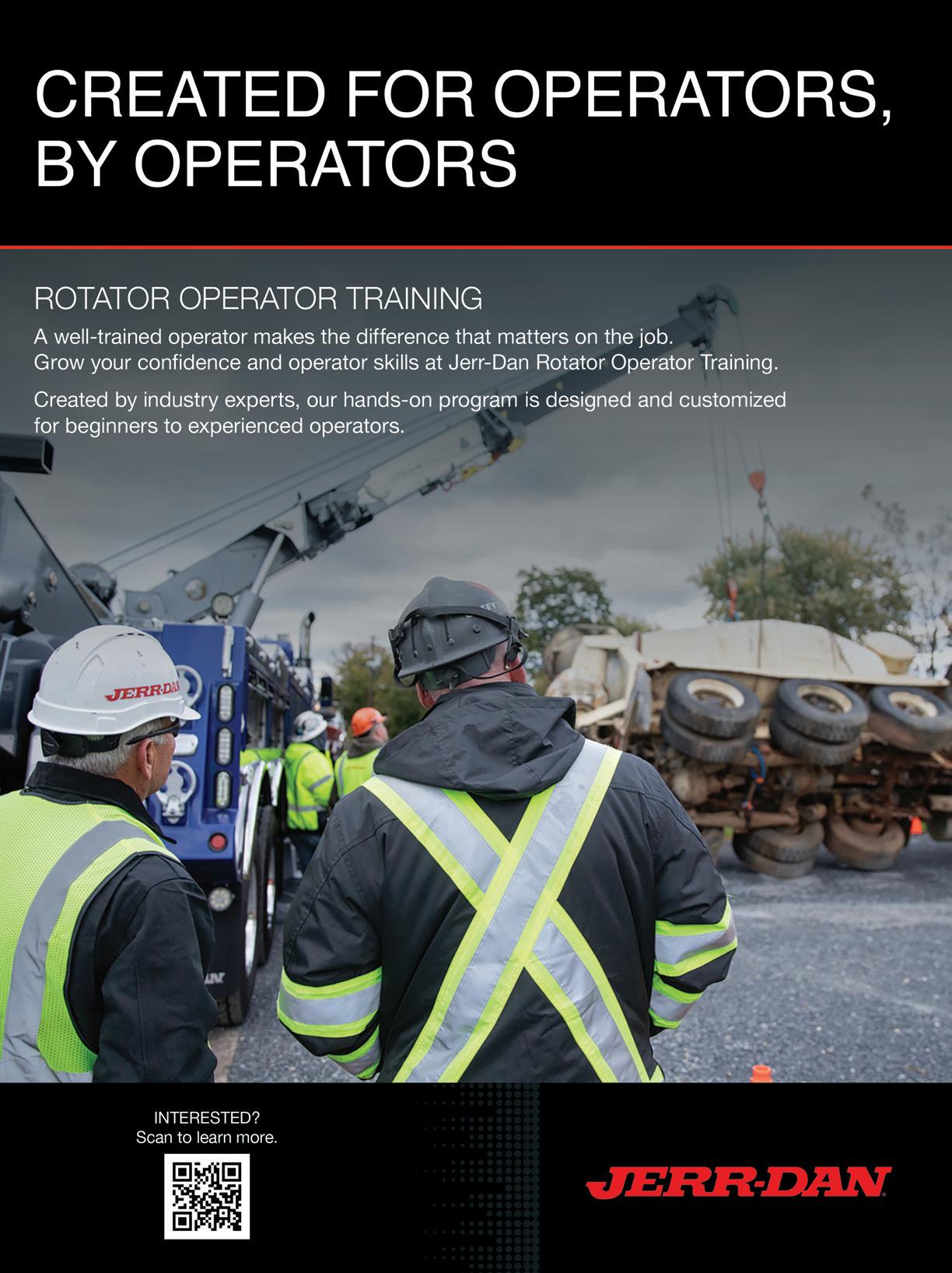


 by John Borowski
by John Borowski
 by George Nitti
by George Nitti
To vividly illustrate our Special Safety Issue, here’s a shot from a recovery by Sterry Street Towing. While the casualty truck was not a wrecker, it did have a boom that got caught under a low-hanging bridge, a good reminder for tow truck drivers to look in all directions for safety’s sake. Photo courtesy of Sterry Street Towing.

 by Brian J. Riker
by Brian J. Riker

6 • May 2023 | Towman.com Contents Volume 47 Issue 5 First on the scene since 1977 The Walkaround News Share Road Tools Zoom In Safety Tow Boss Repo Run Ad Index Classic Wrecker Tow Operator Hands-On Tech Beacons On! Supplier Scoop Towman’s Market My Baby Lowdown Adventures of A.T. 8 10 12 13 14 20 28 34 42 46 54 58 64 68 70 74 81 Roadside Quick Clearance Procedures
Firsthand Fails from a Veteran Towman
Are We Clear?! Typical Towing Mistakes 14 20 Features
Departments
Attention to a Low Overhead
Pay
Watch Yer Noggin’! 36 Cover Feature May 2023

The Walkaround
Key Points on Safety
Safety is not only the theme this month, but should be a main consideration of each and every tow business, each and every day.
Dennie Ortiz Publisher
As there are countless aspects of safety involved in this industry, in this issue we focus on a few that are key. John Borowski starts us off with his declaration on the importance of quick clearance and why it’s in the operator’s best interest of all on scene to be off the
roadway as soon as possible.
Everyone at some point in their lives will make a mistake while at work. The distinction for our industry is that a single misstep can be costly and deadly at its worst. Brian Riker runs down the list of common ones to avoid that he himself has made and learned from.
Repo has its own set of safety concerns. Later in his article, Mark Lacek, Repo Guru, provides practical advice on how to best prepare to be a certified repossessor. Spoiler alert—just as in towing, training is the key!

Anyone driving larger trucks, including towers, must be able to see and interpret height signs. Our featured recovery presents a circumstance where bridge height caused a major incident, though the casualty was able to be safely recovered in record time.
As we gear up for motorcycle riding season, Randy Resch offers specific recommendations for safely towing motorcycles. One big take-away from his piece is the need to invest in the proper tools for these unique vehicles.
For tips and techniques on the safe use of self-loading tow dollies continue reading to Terry Abejuela’s article detailing the do’s and dont’s of this very useful piece of equipment.
On a lighter note, at the AT Expo last year I had the privilege of meeting Farah Whittenberger. A very poised young woman who at the tender age of 15 years, already has great passion and enthusiasm for our industry; so much so that her father eagerly introduced her to American Towman’s editor Steve Temple and myself in the hopes of contributing to the magazine. A brief but candid look through the eyes of this young tower will give towmen and tow-women of all ages hope for the future of this industry. See page 60.
As always, be safe and stay safe out there!
Tribute Trucks
Steve Temple Editor
While the theme of this issue is all about safe towing, I’d like to draw attention to a couple of wreckers that acknowledge the sacrifices of others. One is an old Ford that Pepe, Jr. bought specifically to recreate his father’s first truck, when he was struggling to earn a living in Los Angeles. What’s striking is how Pepe, Jr. never forgot how hard both his dad and mom worked to care for their family, a very heartwarming expres-
sion. A good lesson for all of us—to treasure our loved ones, both now and after they pass. (Also mentioned in the article “Balancing Act” about work and family.) To drive home this point even further, HBL Towing’s “Fallen Officer” wrecker displays the ultimate sacrifice of police officers in the line of duty. It’s a moving symbol of sacrifice for so many others in recent times. We will do well to follow their example in paying tribute, as done in American Towman’s Spirit Ride.
Dennie Ortiz
Steve Calitri
Steve Temple
Randall Resch
Terry Abejuela
David Kolman
John Borowski
Mark Lacek
Brian Riker
George Nitti
Henri “Doc” Calitri
President Editor-In-Chief Editor Operations Editor Field Editor, West Chassis Editor Safety Editor Repo Run Editor
Contributing Editor
Contributing Editor
Contributing Editor
Editorial Board
Tommy Anderson
Roy Carlson
Debbie Collins
Belinda Harris
Bill Johnson
Kurt Wilson
Dallas, Texas Saint Paul, Minn. Las Vegas, Nev. Greensboro, N.C. South Hadley, Mass. Creve Coeur, Ill.
American Towman Staff
Anne Ruzsilla
Dennie Ortiz
Ellen Rosengart
Henri Calitri
Peggy Calabrese

Ryan Oser
Stephanie Marchese
Andrea Wynn
Emily Oz
Art Director Advertising Sales Mgr. Senior Account Exec.
Customer Service
Regional Advertising Sales
iMarketing Manager
Publisher’s Assistant Subscription Manager
ATTV Producer
American Towman Media Headquarters 2 Overlook Drive, Suite 5, Warwick, NY 10990 800-732-3869 or 845-986-4546
President Editor-In-Chief Editor Subscriptions
E-Mail: dortiz@towman.com scalitri@towman.com stemple@towman.com subscriptions@towman.com
itowman.com
americantowman.com
towindustryweek.com americantowmantv.com
Copyright ©2023 American Towman Magazine is published 12 times a year by American Towman Media, Inc.
Subscription: Single Copy: $10 1 yr: $60 – 2 yrs: $110
International: $75 & $135
All material published through American Towman Media (AT), to include American Towman Magazine, iTowman.com and TowIndustryWeek.com, including advertisements, editorials, articles and all other content is published in good faith. However, AT accepts no liability for any errors or omissions, and does not endorse any companies, products or services that appear. AT does not test or review products submitted for inclusion in its publications. AT does not accept responsibility for the accuracy of content, warranties or claims made or implied by its advertisers. The views expressed are the authors’ alone and do not necessarily reflect the views of AT. The act of mailing or delivering a letter, email or article to AT shall constitute permission to publish that letter or article or any portion thereof. AT reserves the right to edit any and all material submitted. No part of the magazine or websites may be reproduced without prior written consent of AT. AT reserves the right to not publish advertisements that disparage competitors or call into question the integrity of a competitors product or service.
2023 | Towman.com
8 • May
AT’S Digital Edition AT’S Website AT’S Weekly ATTV

Opposition to Towing Legislation
The Towing and Recovery Association of American (TRAA) has submitted a comment in opposition to Docket No. FMCSA-2023-0071 based on the belief that allowing the use of amber, or other color, warning beacons in place of the traditional warning devices such as flares, fuses or reflective triangles will increase the motoring public’s disregard and desensitization to warning beacons when displayed for true emergencies. Further, as submitted, the exemption request may be in direct conflict with current emergency lighting use regulations in several states and most definitely conflicts with the intended use of amber warning beacons. Most states do not allow use of amber warning beacons unless a vehicle is presenting a direct hazard to traffic such as being slow moving, stopped in an active lane of travel, or otherwise specifically required by law. By adding yet another group of vehicles displaying amber beacons, the TRAA argues that the motoring public will be further confused as to the intended meaning of the caution light and/or their responsibility when approaching a vehicle displaying such lights.
source: traaonline.com
Cop Pleads Guilty in Towing Scandal
A former Detroit police officer was found guilty on March 24 for taking bribes from a tow company owner.
Michael Pacteles faces up to ten years in federal prison for accepting bribes, including a vehicle and $3,200 from the unidentified owner. In return, Pacteles provided sensitive police information, including vehicle registration data from the restricted database Michigan Law Enforcement Information Network, or LEIN, prosecutors alleged. Sentencing is set for Aug. 30.
Pacteles is the fifth city official to plead guilty in an ongoing federal corruption investigation, “Operation Northern Hook,” which emerged publicly in August 2021 when FBI agents raided multiple locations across Detroit, including City Hall.
Source: detroitnews.com
Washington Legislature Passes Blue Lights Bill
A Senate Bill passed the Washington State Legislature on March 24 which allows tow truck drivers to use flashing red and blue lights while working the scene of an accident. The bill is now awaiting the signature of Governor Jay Inslee to become law.
“We want drivers to be more aware and more cautious, especially when you have workers working along our roadways who are there to do a job that benefits all of us,” said Jeff Wilson (R), who introduced the bill. “I’m proud that we completed this and I hope it will save lives.” The law also requires drivers on highways to slow down to 50 mph or below while passing an emergency or work zone.


The bill was named after two
Washington state tow truck drivers who were killed on the job in 2021: Arthur Anderson, owner of Anderson Towing and Raymond Mitchell.
Source: tdn.com
Advocating Stiffer Penalties on SDMO Law
Roadside accident survivors, widows and support groups made the trip to Austin, Texas to speak in favor of House Bill 898, which would impose stiffer penalties for failure to comply with the Slow Down Move Over (SDMO) law. Currently, a violation in Texas could cost $200, but if the law is enacted, fines could increase to $500 to as high as $1250 for a first-time offense, and $1000 to $2000 for a second-time offense.
Mitzi Morin, the widow of Patrick Morin, a tow truck driver who was struck and killed five months ago, gave
testimony in support of the bill.
“I want to draw attention to this bill because our emergency responders are being struck and killed or injured…at a very high rate,” said Morin. “It’s been in the media, but you don’t hear a lot about Slow Down Move Over.”
As it stands, the SDMO law requires drivers to change lanes or reduce their speed when first responders are working roadside. If enacted, the stiffer penalties would go into effect September 1, 2023.
Source: kwtx.com
Washington State Representative Jeff Wilson introduced a new towing safety bill.
News share 10 • May 2023 | Towman.com
Groups gathered in Austin, Texas to advocate for stiffer penalties for violating the Slow Down Move Over Law.
Wisconsin Reckless Driving Law
To crackdown on reckless driving, Wisconsin’s state legislature presented a bill that was passed by the state assembly to Governor Tony Evers, who signed it into law on April 3. The new law, Wisconsin Law Act 1, empowers Wisconsin municipalities to pass legislation to tow and impound cars involved in repeat reckless driving.

Tower Reports
Influx of Abandoned Vehicles
The law is modeled after a similar policy that has been enforced by the Milwaukee Police Department over the last year.
Last May, Milwaukee police began towing unregistered vehicles in an attempt to curb the city’s reckless driving epidemic. The policy also allows officers to tow vehicles when drivers are cited for driving recklessly, speeding in excess of 25 mph, fleeing an officer, or street racing.
“I’m glad reckless driving is the first issue we’re addressing this session, but our work cannot stop here,” Evers stated. “I call on the Legislature to support my budget initiatives that will build on this bill and make our roads safer by taking a statewide, multi-pronged approach to urgently addressing reckless driving and dangerous behavior on our roads.”
Source: tmj4.com wisconsinexaminer.com
Connecticut Increase in Towing Fees Falls Short
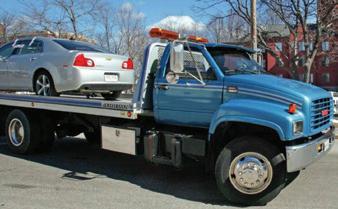
Under pressure from towing companies to raise towing rates, the DMV of Connecticut approved a slight increase in basic towing fees, allowing the basic hook-and-tow charge to increase to $125, and the per-mile rate to climb to $5.65 after the first two miles. The new rate will took effect on May 1.
However, the DMV denied the proposed 60 percent increase that tow companies sought, nor did the department approve their request for an increase in storage fees. Citing rising costs to run their businesses, Michael Festa and other tow company owners had asked for higher fees for removing and storing vehicles that are taken away from crashes or violating private parking rules. They wanted the current basic towing charge of $105 plus $4.75
per mile be raised to more than $167 and $7.58 per mile.
The request to increase storage rates for vehicles under 20 feet from the current $30 to $47.87 was denied, as was a request to raise the rate of $37 for more than five days to $59.04.
Source: ctinsider.com
Meier Towing in Sioux City, Iowa reports recovering more abandoned vehicles throughout the city, particularly in the aftermath of winter.
“Vehicles come to the yard for lots of various reasons,” said Jeff Day, manager of Meier Towing. “I mean some of them are towed for abandoned, some of them people are arrested, some of them the vehicles are in accidents.”
Weather also plays an important role on how many cars are towed a month. At this time, Meier Towing has between 100 and 150 cars in their lot, and is seeing higher auction sales, where 60 of those cars were expected to go to auction at the end of March.
“This is right up there with one of the larger sales that we’ve had,” Day added. “Usually we are holding six different auctions in a year, and we will usually sell somewhere between 30 to 50 vehicles every auction.”
Source: siouxlandproud.com
Florida Illegal Towing Business
A Florida man faces numerous criminal charges after police said he operated an illegal towing business and, along with an accomplice, stole parts from a car in a parking lot.
The incident involved Pedro Martin, which touched off an investigation after Martin was seen stealing parts from a car that he would eventually tow along with another man. Surveillance video captured the episode, implicating both men.
Police later found that Martin’s tow truck business did not have the requisite markings, licensing or paperwork to legally operate.
Both men face charges of burglary and grand theft, while Martin faces additional charges of towing a vehicle without commercial markings, a thirddegree felony, and failing to maintain or produce records regarding a towing business, a misdemeanor. He also faces multiple local ordinance violations.
Source: local10.com/
Wisconsin Governor Tony Evers signed into law a bill aimed at thwarting reckless driving.
News share AmericanTowman.com | May 2023 • 11 Work the non-traffic side - Stay Safe!
Connecticut DMV granted an increase in basic towing rates but fell far short of what was sought.
road Tools
Ranger Mission
Lincoln Electric’s new Ranger Air 260MPXTM is a multi-function unit designed specifically for demanding worktruck applications. This versatile, all-in-one machine features an air compressor, generator, battery charger, battery jump assist and multi-process welder. By eliminating the need to carry numerous pieces of power equipment on a service truck, the Ranger Air 260MPX provides a lighter payload and more space on a tow truck for other tools and gear. Components include a Vanair compressor that delivers 40 cfm at 150 psi, as much as 30% more air than other machines in its class, so operators are able to inflate tires faster and power anything up to a one-inch impact wrench. In addition, a 26.5-hp Kohler engine delivers 10 kW of continuous AC generator power. Also, Lincoln Electric’s welding arc control technology is built directly into the Ranger Air 260MPX. lincolnelectric.com

Easier Fleet Management
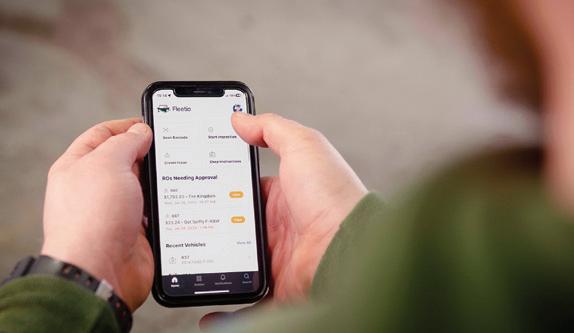
fleetio.com
Getting Pumped Up
To correct durability issues with the CP4 high-pressure fuel pump on Ford Super Duty trucks powered by the 6.7L Power Stroke diesel engine, S&S Diesel Motorsport teamed up with PurePower Technologies, Inc. They developed an alternative specifically for the Ford 6.7L Power Stroke which matches the CP4 output curve and does not require any calibration changes. Combining that with OEgrade braided hose and steel fuel lines creates a more-reliable CP4 replacement that looks and performs like original equipment. The two-piston DCR pump is based on a compact and modular design for easy integration, with low hydraulic and acoustical noise, and ultra-fast response times. Both biofuel and low-lubricity fuel compatible, this unit uses a patented eccentric drive pumping technology for increased performance, efficiency, and durability. It also comes equipped with Stanadyne’s new corrosion-resistant inlet metering valve (IMV) designed to extend DCR fuel pump life.
Fleetio’s suite of cloud- and mobile-based fleet management solutions enables fleets of all sizes to automate operations and manage asset lifecycles. Users can instantly access and update data regarding inspections, scheduled and unscheduled maintenance, parts, fuel, drivers, and much more. Fleetio improves communication and streamlines issue resolution with its mobile app, email notifications and reminders. Fleetio also integrates with telematics solutions for automated odometer updates, DTC handling and fuel location reporting that pairs with fuel cards to automatically log transaction data during fueling. Fleet managers, drivers, technicians, parts managers and other personnel have access to the tools and information they need anytime, anywhere. Fleetio powers public and private fleets in more than 80 countries in industries such as towing, consumer and business services, construction, transportation, and many others.

12 • May 2023 | Towman.com
ssdiesel.com/FordDCR
RAV Reviews
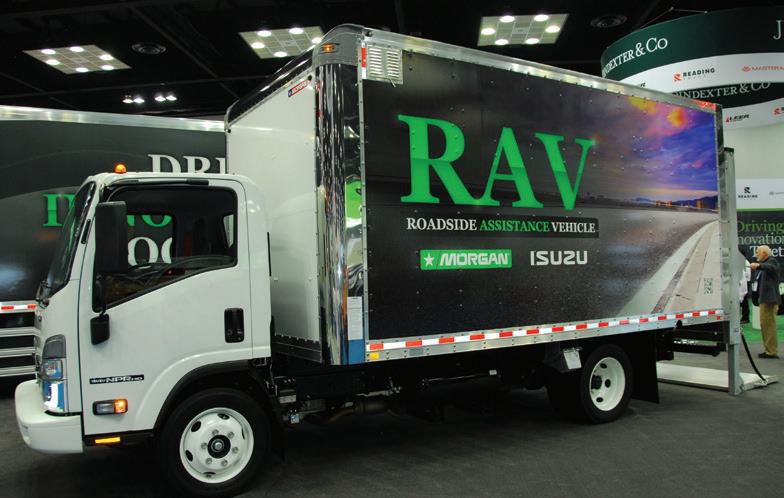
Morgan Truck Body’s new RAV (Roadside Assistance Vehicle) is virtually a “repair shop on wheels.” It offers easy and convenient access to the parts, tools and equipment that towers need to provide roadside service. Mounted on an Isuzu NPR-HD, gaspowered, 14,500-lb GVWR chassis, the RAV features a mobile workshop with easy access through either a curbside step door or a rear lift gate. There are packages for oil, lube, cooling fluid, air, parts, welding, and diagnostic testing. Included is a workbench with an aluminum structure and a stainless-steel top, plus ample parts and tool storage in Masterack fixed shelving. For extra safety and illumination, dimmable LED strobe lights and scene lights are located curbside for a bright work area at night. In addition, the RAV offers enhanced safety with Morgan Situational Packages camera views of what’s happening behind and around the truck, as well as in the cargo bay. In addition, Situational Awareness (SA) Packages offered by Morgan employ advanced technology focused on reducing collision risk, driver overload and hazardous conditions. This includes DVR incident recording for evidence and accident capturing. The RAV is available in either 16-foot or 20foot lengths.

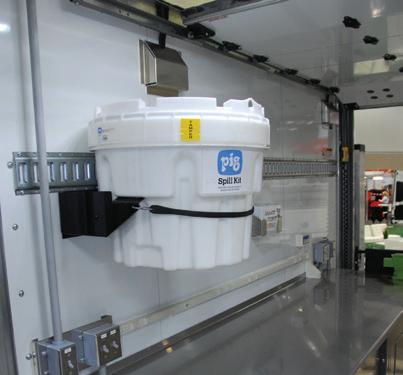


AmericanTowman.com | May 2023 • 13 Work the non-traffic side - Stay Safe! Zoom In
morgancorp.com
Roadside Quick Clearance Procedures Are We Clear?!
By John Borowski
There is no question that everyone would like to see towers’ roadside hits and deaths come to an end. The risks are obvious—and so are the remedies. Emergency workers on roadway sites are exposed to low visibility, severe weather, and oblivious drivers, all of which make the towman’s job extremely hazardous. While some have safety training, the drivers on the road do not, so it is vital to proceed with extreme caution.
Annually, about 60 or more tow truck operators are killed on public roads. The ugly fact is that realistically these deaths and injuries will not stop, but we need to work at lowering the current rate, which is one every six days! While we are all concerned for our towers’ roadside safety, there are several things in particular that can help relieve some of that stress and minimize hazardous exposures.
To start with, the normal inventory on your truck should be well organized. Every time that a tower starts their day, a

daily circle check should be done. All of the needed equipment should be evaluated for its location, where it is supposed to be stowed, and its working condition. The less time a driver is exposed to moving traffic and bad weather conditions, the better. It is definitely not the time to be digging through tool cabinets roadside to locate something.
PIT STOP SPEED
As an analogy, tow truck operators should watch and understand how a NASCAR pit stop happens. After all, it’s basically the same thing, except in a race it’s about winning, and on the roadside, it’s about living.
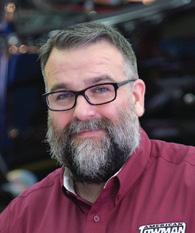
For comparison, in 1950 a NASCAR pit stop took 55 seconds, in 1970, 33 seconds, and in 1980, 20 seconds. Last year, crews got it down to 8.6 seconds. The obvious point is that with training and practice, these roadside duties can be shortened, meaning less exposure, which equates to fewer hits and deaths.

14 • May 2023 | Towman.com safeTy
In a race it’s about winning, and on the roadside, it’s about living.
John Borowski has over 45 years experience as a tow business owner, wrecker manufacturer specialist, trainer and writer. He was awarded the first “Towman of the Year” by American Towman magazine and two Towman Medals for heroism. He was inducted into the Towing and Recovery Hall of Fame in 2001.
Alert oncoming traffic by wearing high-visibility apparel and PPE, and use tow truck warning lights as well.
COMPANY PROCEDURES
Tow business owners or managers should do the following:
• Provide training for all workers exposed to dangerous roadside conditions.

• Instruct operators to evaluate the situation of their call as they approach the disabled vehicle.
• Park the tow truck ahead of the casualty so that the tow operator does not have to pull out and go around the casualty. Pulling out and in front of the casualty at 5 mph with speeding traffic coming at you poses an obvious collision risk.

• If the casualty is blind to oncoming traffic, get a warning device upstream of the incident.

• Post signs, cones, reflective triangles, or another vehicle (law enforcement), in order to warn the oncoming traffic that there is an incident ahead, and to slow down and move over.
• Engage tow truck warning lights as well. What else can an operator do to minimize the hazards of roadside service? Safe operator procedures include:
• Always wear high-visibility apparel and PPE, such as hard hats, hearing protection, long pants, work boots, and gloves.
• Be aware of vehicle travel paths and avoid standing or walking in those areas.
• Know your blind spots.
• Remember your safety training.
• Never lose sight of approaching traffic.
• Always have an escape route planned, if and when needed.
• Get your driver and occupants of the vehicle being towed into your truck cab or upstream and away from the traveling traffic until their ride is ready to depart. This is not the time to wander or take possessions from the vehicle being towed. Additional safety practices for roadside vehicle operators include:
• Maintain contact with a spotter when backing up if necessary. If contact with the spotter is lost, stop immediately.
• Inspect vehicles, equipment, and safety devices
AmericanTowman.com | May 2023 • 15 Work the non-traffic side - Stay Safe!
◀
With training and practice, recovery times can be reduced, minimizing exposure to hazards.
before pulling out and exiting the scene.
OBEYING SDMO LAWS

During a recent survey, 23 percent of the people quizzed were unaware of the SDMO (Slow Down Move Over) law in the state where they live. And among those who were aware of their state’s law, 15 percent reported that they were unaware of the consequences for violating it. The following tragic incidents show just how seriously SDMO law should be viewed.


Glenn Ewing, 32, was killed on July 4 near Cincinnati, OH, while placing a disabled vehicle on the back of a flatbed on the side of the road. He left behind a fiancé and two children.
Only three weeks later, 30-yearold David Meyer was assisting a driver on the left-hand shoulder in Castle Rock, CO, when he was also struck and killed. As of August
16 • May 2023 | Towman.com
◀
The driver and/or occupants of the casualty should be kept away from a recovery procedure.

2021, 14 tow providers were killed while helping others on the roadside.
“Deaths like these can be avoided if drivers slow down and move over to give these people room to work safely,” pointed out Marshall Doney, AAA President, and CEO. “We can’t stress enough how important it is to pay attention so you have time to change lanes when you see an emergency responder, or simply anybody along the side of the road.”
RISKY BUSINESS
Startling new data from the AAA Foundation for Traffic finds that among drivers who do not comply with SDMO laws at all times, some 42 percent thought this behavior was only somewhat or not dangerous at all to roadside emergency workers. This statistic demonstrates that drivers may not realize how risky it is for those working or stranded along highways and roads close to
moving traffic. Nor do they realize the potential penalties.
In Colorado, for instance, drivers face a $70 ticket, four penalty points, and a misdemeanor charge for failure to move over or slow down when approaching an emergency vehicle, tow truck, utility vehicle, or road maintenance vehicle with flashing lights on the side of the road.

Ohio’s Move Over law requires all drivers to proceed with caution, and if possible, move over one lane when passing an emergency vehicle, tow truck, municipal vehicle, or road maintenance vehicle with flashing or rotating lights parked on the roadside. Violators can face fines up to $300 for a first offense.
It’s not just towing providers and other emergency responders being killed on the side of the road. Since 2015, over 1,600 people have been struck and killed while outside of a disabled vehicle. The reality is

18 • May 2023 | Towman.com
that drivers are increasingly distracted while driving. Research has found that drivers are up to four times as likely to crash if they are talking on a cell phone while driving, and up to eight times as likely to be in a crash if texting.

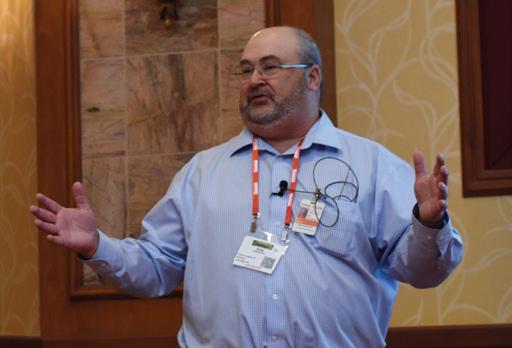
We need to get this problem under control as towers. The general public does not seem to be too concerned about the serious distractions that are causing these fatalities.

AmericanTowman.com | May 2023 • 19 Work the non-traffic side - Stay Safe!
Ron Myers, above, emphasizes tow operator safety in the Quick Clearance course he authored and conducts at American Towman shows with John Borowski.
Typical Towing Mistakes
Firsthand Fails from a Veteran Towman
By Brian J. Riker
We all love to celebrate our successes and hide our failures. Yet there is much more to learn from a mishap on the job. A mistake can be costly, but the education resulting from a failure is also priceless.
in the towing industry on many levels. Understanding your equipment’s capacity and the stress you are placing on it, whether lifting, winching or simply hauling a vehicle, all require a basic understanding of math.
For instance, one example would be having a clear understanding of what a truck weighs empty (the tare weight), what each axle and tire is rated for, the loaded weight, and how that weight will be distributed across the axles and tires. Another would be understanding the weight and forces placed upon rigging when winching and lifting.
Brian J. Riker is a third-generation towman, with 26 years of experience in the ditch as a tow operator, and president of Fleet Compliance Solutions. He specializes in helping navigate the complex world of federal and state transportation regulatory compliance. He can be reached at brian.riker@fleetcompliancesolutions.net

What are the most common mistakes in towing? That is a loaded (no pun intended) question. Let’s begin with selecting the right equipment for the job, and then I’ll share some other personal shortfalls in my 30some years of towing experience, plus a few other common hazards.
HIDDEN FIGURES
First, know your numbers! While math might not be a favorite subject for many, especially those that prefer to work with their hands, it is critical to success
Besides selecting equipment that can’t handle the weight, size and type of vehicle being serviced, and pushing equipment beyond its design capacity, where else do towers make avoidable mistakes?
DON’T GO CHEAP
New towers may be budget conscious and purchase low-cost tools and equipment. Unfortunately, these more affordable tools are usually of lower quality, leading to damage claims that far exceed the cost difference of acquiring a better tool from the get-go. This ill-advised practice often occurs
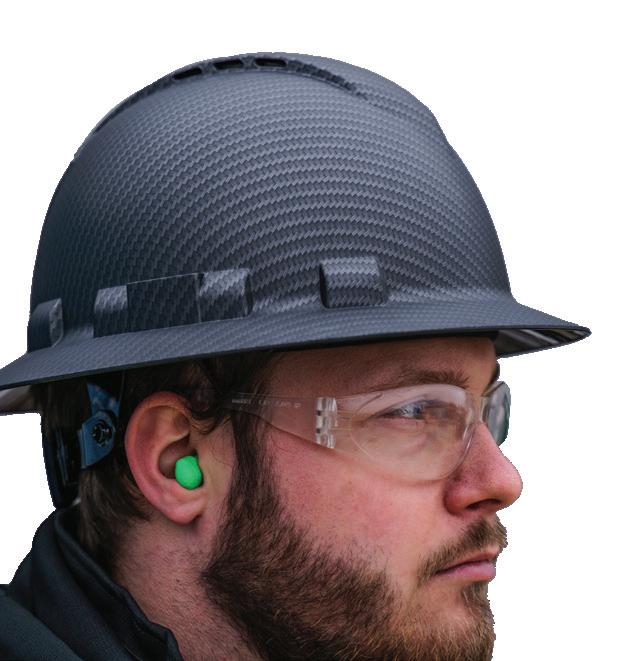

20 • May 2023 | Towman.com
Tow Boss
Safety-conscious towmen don’t make the mistake of not wearing eye, ear and head protection, along with a high-visibility vest.
in the medium-duty segment, when an operator is just starting to move up from light-duty and needs to get a tool kit for driveline removal. The problem is, low-quality tools end up rounding off driveline bolts, resulting in calling for backup help, maybe even cutting the driveline bolts and straps off the disabled vehicle.

The same can be said for lockout tools, jumpstart packs and rigging supplies on your trucks. A lowquality jump pack will leave both you and your clients disappointed and could even be a fire risk. There have been reports of jumpstart packs shorting out and igniting truck fires while just sitting in the cab, even when not in use. Investing in good tools early on will help you build your skills and reputation as a professional tower.
HEAD, HANDS AND TOES
Another mistake is not using personal protective equipment (PPE). I am not just talking about a highvisibility vest. Safety glasses and gloves are often overlooked, leading to increased injuries and workers’ compensation claims, which can be costly to tow bosses and even careerending for operators.

As a working operator, I admit to having been terrible about using PPE and paid the price with damaged hands, eye injuries from debris,
and permanent hearing loss from exposure to loud noises. All of which could have been avoided by wearing basic PPE.
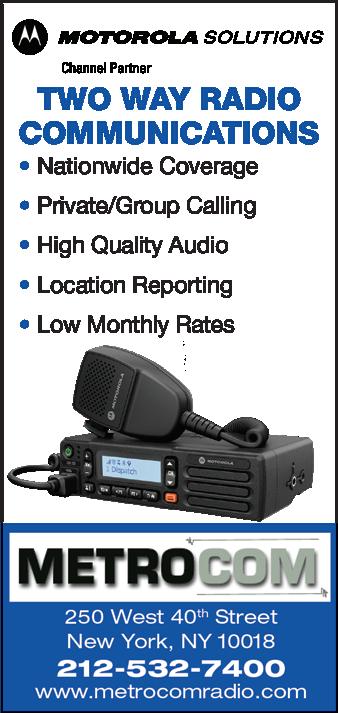
FEELING TOO TIRED?
Remember that famous movie line, “A man’s got to know his limitations”? It’s especially true
AmericanTowman.com | May 2023 • 21 Work the non-traffic side - Stay Safe!
◀
Good lockout tools can minimize risk of damage and make for quicker access.
for tow operators when working long hours and running low on sleep. Fatigue is dangerous, making us prone to committing simple errors, and we are not superhuman, no matter what we’d like to think.
Again, looking back at myself in my younger years as a tower, I had a desire to serve everyone and always said “yes” to any job. It wasn’t uncommon for me to work two or three days straight during a storm, or take a multi-state trip that would take a few days and complete it without a rest break. There were many trips where I couldn’t recall how I got where I was, or even where
I was, due to lack of decent sleep. While I was fortunate to never have had an accident, I have no idea how many close calls I may have had, and that frightens me today, mostly because I know of folks that have lost their lives due to falling asleep behind the wheel of their truck. It is simply not worth the risk.
THE LONG AND WINDING ROAD
I was again reminded of this sad fact while preparing to drive a rotator to a tow show more than a thousand miles from my home. Even though tempted to just push



22 • May 2023 | Towman.com
Heavier vehicles, especially EVs, or those with damaged rims, require specialized loading equipment, such as Zip’s Guniwheel, so the winch cable doesn’t get overloaded or damaged.
through and complete the trip in one day, I chose the path of safety and compliance, and took almost three days to cover the distance. I can assure you that I was much more relaxed and refreshed when I arrived than if I had tried the other approach, pushing through fatigue and ignoring the hours-of-service rules.
When making these long trips, especially if you don’t regularly handle long drives, you need to be aware of fatigue and how it can come upon you suddenly. You might feel fine but in reality, are already experiencing “micro sleeps,” dozing for brief periods lasting two or three seconds, where you do not realize your mind is asleep even though your eyes are open. Caffeine, cold air and slapping yourself do nothing to help—the only cure is to stop and get rest.
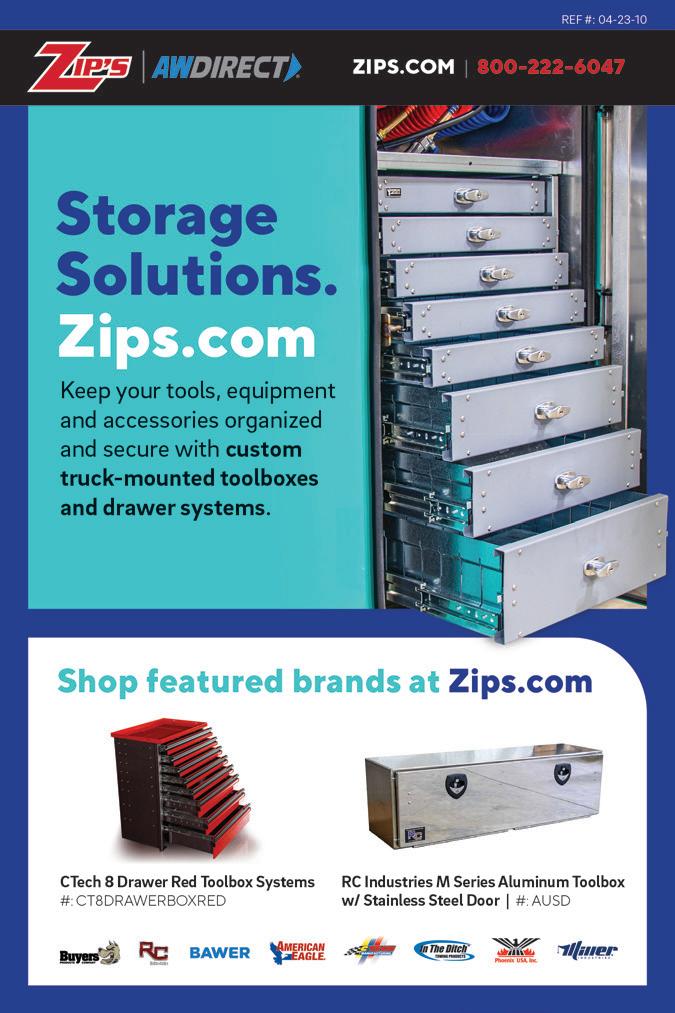
ROAD HYPNOSIS
Being sleep deprived can have the same effect as intoxication; slowing reaction time, and causing impaired vision and poor judgement. The latter is the number one cause of all accidents across the United States. In fact, one study found that in cases where the truck driver was at fault, it was driver error that accounted for 87 percent of those accidents.
Driver negligence includes speeding and distracted driving, such as cell phone use, operating navigation devices, and even eating while behind the wheel—anything that takes your attention away from driving. In a world in which most people have smartphones within arms-reach nearly all the time, a tower might be tempted to reach for the phone and answer a message, respond to an email, or check notifications. Looking away from the road, even for a few seconds, impairs a driver’s ability to recognize and respond to road hazards. ◀
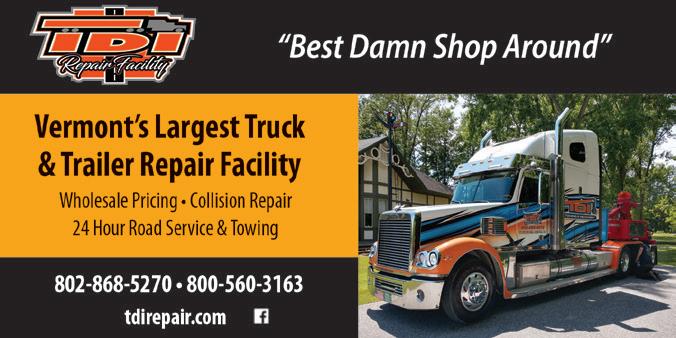
AmericanTowman.com | May 2023 • 23 Work the non-traffic side - Stay Safe!
NO SEE-UMS
Obviously, basic maneuvers such as braking, changing lanes, and making turns require having good visibility. Tow truck operators handling recoveries often have to work in poor weather conditions, on difficult terrain, and in isolated areas. They’re at risk for slipping on ice or snow, sliding into a ravine, and even encountering rockslides and wild animals. Operators should always be alert to these dangers to prevent serious harm.
In addition, poor maintenance or ignoring mechanical issues can cause tow truck accidents. These include worn or broken tie-downs, unweighted steering due to a heavy load, faulty brakes, and under-inflated tires. Extra friction produced by underinflated tires can lead to rollovers or blow outs, so make sure that tire pressure is correct.
While we can’t cover every potential problem in one article, these are some of the major reminders worth keeping in mind. The towing business commands a great deal of responsibility, and the room for errors is nearly nonexistent. So take note of these typical towing mistakes, and you’ll certainly improve your safety record.


24 • May 2023 | Towman.com



Repo Risks
How to Minimize Them and Stay Safe
By Mark Lacek
If you are in the business of repossessing collateral, you’d better be certified. Becoming certified is the only way to learn the ins and outs of an often misunderstood industry. After all, being a repo man comes with risks, since debtors can become angry and confrontational. This job is not a casual pursuit and requires solid training and good situational awareness—a “Spidey Sense” to keep you safe and out of harm’s way.
Having street smarts starts with taking the time to learn about the repossession laws in your state. Learn the professional repossession industry standards. To be smarter by getting smarter, here are a couple of key resources for becoming a certified repossessor.
RISC MANAGEMENT

The easiest way to highlight the importance of training and certification is to take the words right from the pages of the two leading certification courses, beginning with the Add Certified Asset Recovery Specialist (CARS) repossession certification manual.
Created by Joe Taylor and Stamatis Ferarolis of the Recovery Industry Services Company (RISC), the CARS program is without a doubt the most respected and most utilized resource in becoming a certified and knowledgeable repossession service provider or repossessor.


This manual has been used by repossessors and repossession agencies for many years. The purpose of the certification program is to provide training on acceptable standards of repossessing collateral secured by a perfected lien. Available in all 50 States, it has been referred to in courts and in depositions as “the Bible” for repossessing mortgaged collateral.
AVOIDING VIOLENCE
Some courts consider that violence (or the threat of violence) is not required for a breach of the peace to exist, and that a verbal objection is sufficient to stop a repossession. As a recovery agent, you have the clear duty to retreat and adhere to the practical adage, “another time, another place.” The CARS certification teaches and instructs the repossessor ◀
28 • May 2023 | Towman.com repo ruN
Repo Editor Mark Lacek authored the Certified Commercial Recovery Agent certification program and has more than 30 years of recovery experience. He is the former editor of “Professional Repossessor” magazine. Email him at Mark@commercialassetsolutions.com.
Using Lift & Tow's "sneaker lift," a repossessor can retrieve a car in less than a minute, in order to avoid risk or confrontation.
Add Certified Asset Recovery Specialist (CARS) repossession certification manual.

to always retreat when approached by any individual objecting to the repossession using verbal and/or non-verbal demands.
For more details, the CARS training provided by the Recovery Industry Services Company can be found at www.RISCUS.com. RISC has a long list of options available for the towing company to become trained and certified to conduct repossessions.

AN INDUSTRY LEGEND
Another respected resource is The Eagle Group XX Field Agent Compliance Training (FACT).
Created by Ron Brown and The
Eagle Group. Brown is a repossession industry legend. He has probably conducted more seminars on training repossessors than anyone, and his training guides are accepted by courts and insurance providers.
The primary purpose of the Field Agent Compliance Training (FACT) is to develop a uniform program, primarily to educate and train personnel who work in the field, and who in the course of their duties, come in contact with consumers and third parties. This program was developed by The Eagle Group XX member agencies with a dual purpose.
The first one is to ensure field
agents are properly trained to perform their duties in a compliant, safe, and legal manner. The second purpose is to ensure that the consumers and the third parties the agents come into contact with are treated professionally and fairly. It is imperative for consumers’ privacy rights to be protected. FACT was created to train in the areas of confrontational avoidance, dealing with irate consumers, trespass, and breach of peace.
ON-SITE AWARENESS
As stated by FACT, “With the sight and sound observations, the agent should be able to evaluate the perimeter situation and make the decision to execute or back off and wait for another time or another place.”
In addition, it’s pointed out in the personal contact section of FACT
30 • May 2023 | Towman.com
It is imperative that a field agent knows what constitutes Breach of Peace
that during the course of the recovery process, the agent should desire the best scenario where the mortgaged property is located and recovered with no personal contact with any person. Remember that some courts have ruled that even a perception of threat of violence can be construed as a breach of peace.
It is imperative that a field agent knows what constitutes Breach of Peace. That’s because the moment the peace is breached, the agent loses all rights to self-help repossession under the uniform commercial code.
LENDERS’ DUTIES
Although the law varies somewhat from state to state, the general rule is that secured lenders also breach the peace if they: (1) repossess the collateral despite the consumer’s objections; or

(2) trespass in order to gain possession of the collateral and/or utilize law enforcement to provide assistance during the repossession.
In general, avoid any type of confrontation with anyone. Do not:
1. Continue efforts to recover the collateral after you have been told to leave the premises.



2. Attempt to take the vehicle over the consumer’s or any third-party protest.


3. Identify yourself as a recovery agent to any third party.

(For more information on becoming trained and certified by The Eagle Training Group, you can visit their web page www.eaglegroupxx.com.)

LEGAL PRECEDENTS
It’s vital to understand the facts on how courts have ruled in the past, and how the court’s decision will more than likely come down in the future. The lenders duty to refrain from breaching the peace is non-delegable. The term “non-delegable” means that lenders are responsible for their repossession agent’s conduct, even if the recovery agent is an employee of a recovery agency rather than an actual employee of the lender. ◀
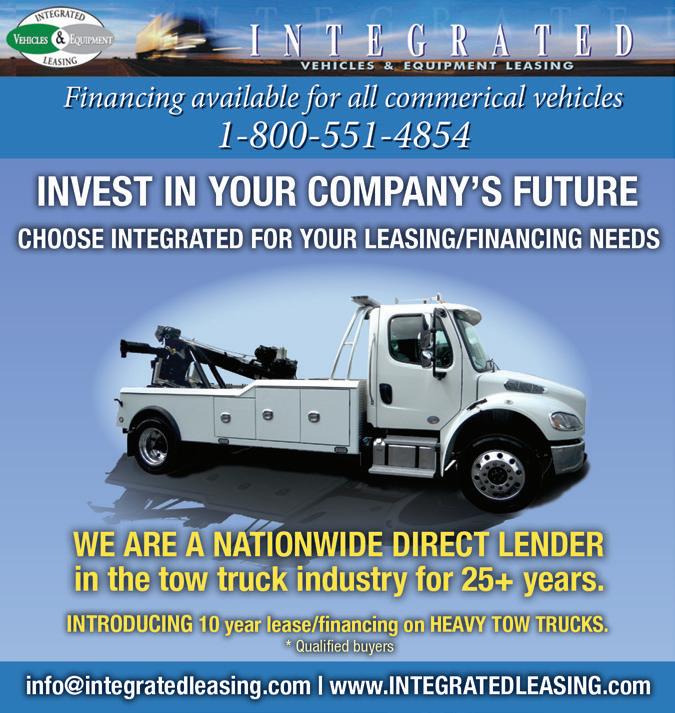
AmericanTowman.com | May 2023 • 31 Work the non-traffic side - Stay Safe!
LITE-IT UP WITH CUSTER PRODUCTS www.custerproducts.com • 800-490-3158
Simply put, if the lender hires an idiot, both the lender and the idiot will be in court.
In states across the U.S., courts have ruled that financial institutions who write loans, including banks, credit unions and title loan companies, are responsible for the actions of their vendors. Lenders often hire a repossession agency based on the lowest fees and not on the quality of the service provided. This poor choice can often end in injury or death.
In many scenarios, a lender will
hire a towing company which may perform repossessions part time just to make ends meet. More and more, towing companies are having to defend their actions in court for not becoming fully engaged in the process of educating themselves and their employees on the laws protecting the consumers. Towing companies must realize, there is more to a repossession than simply hooking up to a car or truck and just towing it away.

KEEP IT SIMPLE
Here’s a quick “acid test” regarding repossessions for all tow companies. Simply contact your insurance company and ask if you are covered to perform repossessions. If your insurance company answers “no”, then the decision is simple—do not conduct any repossessions. If your insurance company answered “yes,” ask the agency to put it in writing, or ask where in your insurance binder it is listed. If you do not see “wrongful repo” within your insurance policy, then you are not insured to conduct repossessions—again, keep it simple.
On some occasions a tow company will be contacted by the lender who will explain that a customer is voluntarily surrendering the collateral. This repossession is called a “voluntary repossession assignment.” Don’t get trapped into this scenario.
A voluntary repossession is a repossession, and the same rules apply. In some instances, a customer will abandon the collateral at the selling dealer and the lender will request the tow company tow the collateral to the auction or to another location. Again, this is considered a repossession and all repossession laws apply. So again, a voluntary repossession is a repossession, which is also simple to understand.
All told, if you are an employee of a tow company and you are asked by your manager to perform a repossession, you must be trained or certified. If you decide to repossess without the proper knowledge, insurance, licensing or training, you will probably land yourself in a legal battle, and you will lose.
Simply put, if you or your company decides to conduct repossession services, you must be certified by one or both of the programs introduced here. If you are in the business of sending an untrained employee into the field to conduct repossessions, you are more than likely going to put yourself out of business.
32 • May 2023 | Towman.com
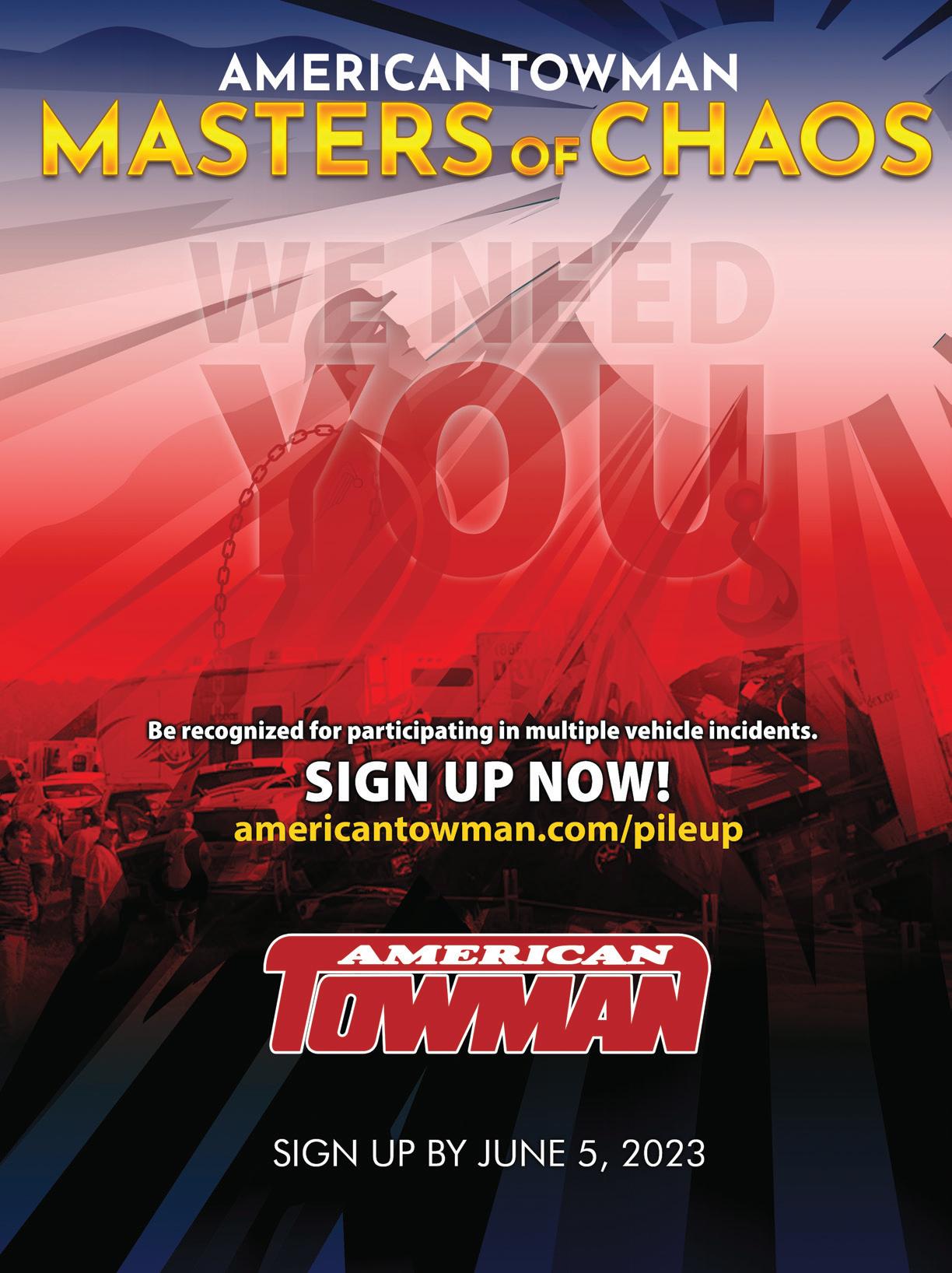

34 • May 2023 | Towman.com
Access Tools 63 Akins Body & Carrier Sales 45 All American Jerr-Dan N, S, M 75 American Society for Asset Protection 39 AT ShowPlace-Las Vegas ................... 40-41 AmeriDeck 57 Ascentium Capital ....................................19 Atlanta Wrecker Sales 39 Austin Insurance W76 Auto Data Direct 55 B/A Products 35 Captain Recovery N, S, M 79 Chevron Commercial 55 Collins 50 Crouch’s Wrecker & Equipment Sales 49 Custer Products 31 Dri-Dek 21 Driverlocate.com ................................... N78 Dual-Tech Wreckers & Carriers 30 Durabilt by Durbin ....................................61 Dynamic Towing Equipment & Mfg. 47 East Coast Truck & Trailer Sales ............ W75 EdgeTech 72 Elizabeth Truck Center 22 ESTRA Tow Show N77 FCar Tech USA W79 First Business Bank 66 GuniWheel 32 G. Stone Commercial N77 ICW Group Insurance 59 Int’l Tow. & Rec. Hall of Fame & Museum 73 Integrated Vehicle Leasing 31 Intek Truck & Equipment ..........................62 ITI Skates 24 Jerr-Dan .......................... Inside Front Cover Khasim Insurance Agency W79 Landoll Corp. Inside Back Cover Len Zermenos 4-5 Lodar USA 16 McMahon Truck Center M77 Metrocom 21 MIDCO SALES W77 Midwestern 16 MIller Industries 9 Mobile Control Systems 62 Mobile Create USA ...................................65 Motorcycle Towing Services 53 New England Truckmaster ..................... N76 North American Bancard 29 Northeast Wrecker Sales ....................... N78 NRC Industries 17 OMG Tow Marketing 18 Online Impound Auctions 57 Pacific General Insurance Agency M78 ParkingSnap.com 52 Peak Wrecker Sales W80 Performance Advantage Company 61 Progressive Commercial Insurance 25 RealWheels Corp. 22 RimSling 15 SafeAll .....................................................19 Santander Bank Back Cover Sea Crest Insurance Agency .................. W80 Speak Easy Communication 18 Specialty Vehicle Equip. Funding 3 Talbert Manufacturing N79 TDI Repair Facility 23 Tow Industries W78 Towbook Management Software 26-27 TowMate 64 TowXpo 33, 69 Tracked Machines 15 Trail King Industries 34 Traxero North America ..............................44 Urgently 59 Utility Trailer Sales Southeast Texas ..........67 Warn Industries 7 We Buy Key Fobs .....................................24 West End Service 53 Will-Burt Company 72 Winches Inc. W76 Wrecker Warehouse W78 Zip’s AW Direct 23, 51 AD INDEX
May 2023

Pay Attention to a
By George Nitti
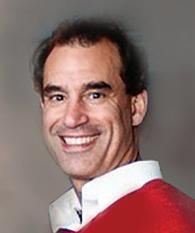
On an early November 1st morning last year, Sterry Street Towing of Attleboro, Massachusetts was called to the city of Wrentham by wrecker company T & D Auto
to recover a roll-off truck that struck a bridge and turned over. Wrentham Fire and Police were also on scene to assist with the recovery.

36 • May 2023 | Towman.com
Low
Overhead
L. Nitti has written for American Towman since 2009. He started out as a news writer and now writes a weekly feature on TowIndustryWeek.com, Tow Illustrated, which spotlights the tow truck graphics.
Watch Yer Noggin’! George
OPERATORS AND SPECS OF TRUCKS AT SCENE
T&D operator
Brian Anderson
2022 Ram 5500 with a Miller bed
Sterry St Towing operators

Andrew White
2020 Peterbilt 388 with a Century 1075 6-winch rotator
Angel Rivera, Sr.
2021 Peterbilt 389 with a Century 9055 tri-axle wrecker
Lead operator Andrew White, who brought in his 1075 Century Rotator on a 2020 Peterbuilt 388 Twin Steer, indicated that the driver had his PTO slightly engaged, which caused the boom to rise while he was driving.
“He wasn’t paying attention,” White explained. “He barely cleared the first bridge he went under, but subsequently hit the second bridge at 40 to 50 miles an hour. The hoist system hit, ripping the garbage can off and flipping it upside down,
while twisting the Mack’s frame rails, and wedging it underneath the bridge.”
White decided that the first order of business was rolling over the container that was filled with garbage.
“Fortunately it had a cover on it to contain the entire load,” he noted. To prevent any spills, his crew used the rotator to carefully roll the can in mid-air, and then loaded it onto another roll-off truck that the company had sent out.
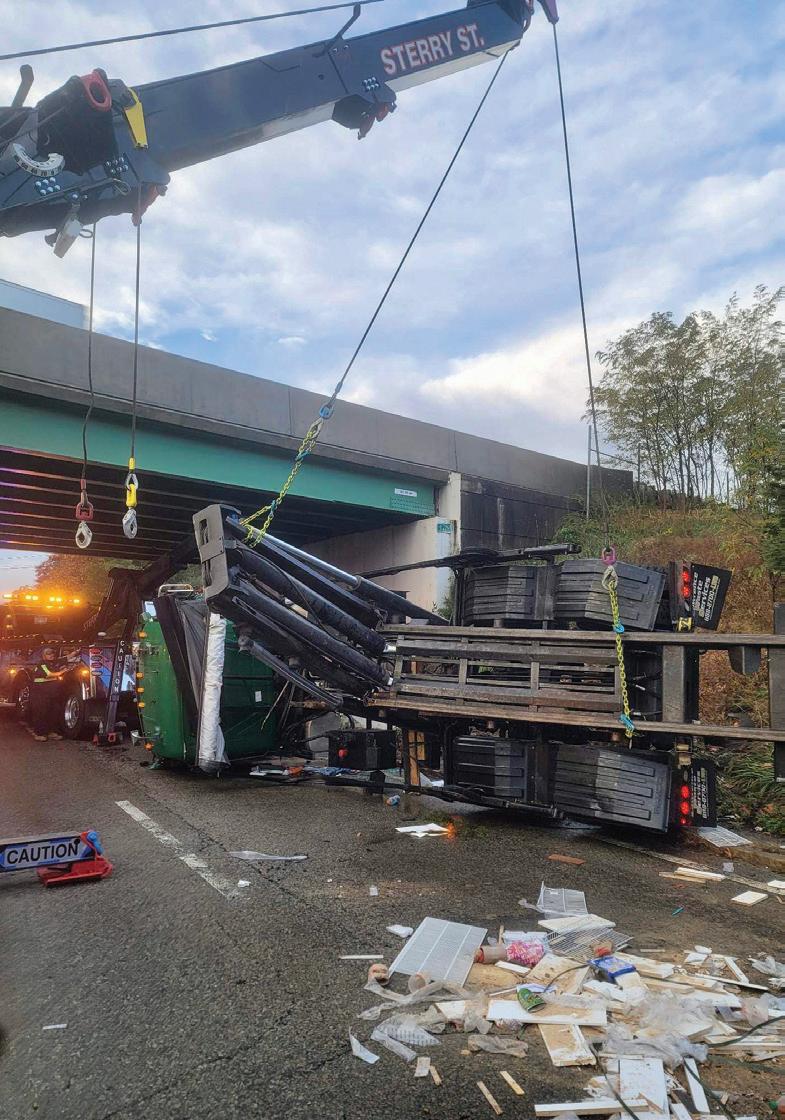
Next, White used the rotator to grab the Mack from under the bridge. Bringing in a 2021 Peterbilt 389 with a Miller 9055 tri-axle wrecker, tow operator Angel Rivera, Sr., positioned his tow truck at the front of the casualty while White maneuvered the rotator further back in order to put the Mack back on its wheels.
Once uprighted, they needed to collapse the damaged hoist and remove the pistons, which were in a vertical position. Although they
AmericanTowman.com | May 2023 • 37 Work the non-traffic side - Stay Safe!
◀
The twisted frame of the rolloff truck had to be pulled out from under the bridge.
attempted to use a ladder to execute this procedure, the ground was wet and covered in 60 gallons of hydraulic oil, making it impossible to lower the pistons without the ladder slipping out from underneath.
To avoid any injuries, the local Fire Chief decided to bring in an aerial platform from a neighboring fire department to assist in removing the pistons.

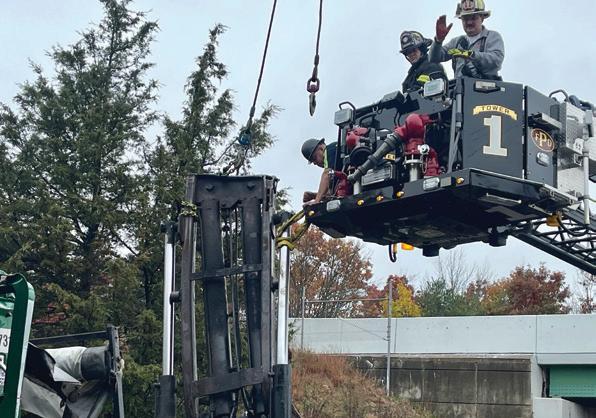


“I already sent one person to the hospital,” the Fire Chief said. “I don’t want to send another.”
White went up on the aerial platform to release the pistons.
“It was the only way that we could get to them,” he admitted. “From the ground, it was about 14 ½ feet high.”
For the disassembly process, “I wrapped the pistons so I could disconnect them,” he related. “I did that for both pistons. I had to physically unbolt the pin and pull the piston away from the mast—then pull
38 • May 2023 | Towman.com
The rotator had to roll over the can loaded with garbage.
A fire truck’s aerial platform was used to assist Andrew White in removing the pistons from the hoist system.
Tow Operator Andrew White wrapped the pistons with a strap so that he could disconnect them from the mast and then use the rotator to lower them down. White had to unbolt the pin and pull and pry the piston away from the mast.
and pry using a six-foot pry bar.”

He then lowered the rigging equipment down to the chassis, with the rotator holding the mast in place along with a second cable which was used to grab onto the piston.
“I had to use both lines at the same time so I could get enough play in the piston to release it,” White recalled.

Once the pistons were removed, the hoist was lowered to a safe transport height and taken back to
the shop. Cleanup of all spilled fluids was taken care of by Massachusetts Highway Department which was also on scene to inspect bridge damage. In all, White estimated the recovery took approximately three hours, remarkably quick considering the complexities involved. All of which could have been prevented by a truck driver just paying a little more attention.
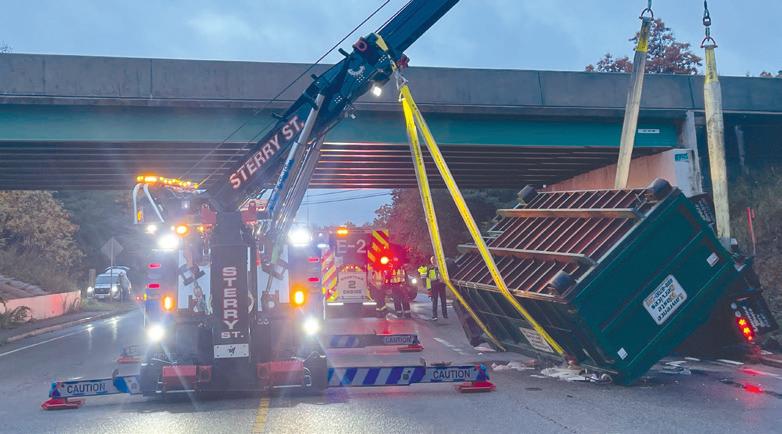
AmericanTowman.com | May 2023 • 39 Work the non-traffic side - Stay Safe!

H2Cyber
- pg. 32
Haas Alert Huntington Bank
Hydraulic Shop
I-Lien
I3 Merchant Solutions
IAA
ICW Group Insurance - pg. 59
Idaho Wrecker Sales
In The Ditch Towing Products
Isuzu Commercial Truck of America
Kalyn Siebert
Khasim Insurance Agency - pg. W79
L&M Environmental Services
Landoll Corporation - Inside Back Cover
Lien Receivables
Lodar USA - pg. 16
Lubnau Gonzalez Insurance Agency
Lynch Denver
McCandless International Trucks
MIDCO SALES - pg. W77
Mike Keith Insurance
Miller Industries - pg. 9
Mobile Create USA - pg. 65
Mobile Road Service Solutions
Mobile Video Computing Solutions
Murphy Bank
Nation Safe Drivers (NSD)
National Automobile Club
National Dispatch Center
Nevada State Tow Association

Nite Beam Products
NRC Industries - pg. 17
OMG Tow Marketing - pg. 18
On Call GPS Video
Peak Auto Auctions
Peddle
Penny Pockets
Phoenix USA
Pruuvn
Questx Towing Services
Ramos Oil Company
RC Industries
RealWheels Corp. - pg. 22
RLX
Roadside Protect
RoadSync
Robinson Oil
Rocky Mountain Wrecker Sales
RP Recovery
RRA Tow Truck insurance/Robertson Ryan
SafeAll - pg 19
Safety Vision
Santander Bank - Back Cover
Schaeffer’s Specialized Lubricants
Sea Crest Insurance Agency - pg. W80
Service Member Data
Silver State Auto Equipment
Southern California Tow Equipment
Specialty Vehicle Equip. Funding Grp. - pg. 3
Stamp Works
Steck Mfg. Co.
TEC Equipment
Telecom Tech Solutions
The Exchange
Tie 4 Safe
TJR Equipment
Todd Equipment
TOMAR Electronics
Tow Buddy
Tow Club
Tow Industries - pg. W78
Tow World
Towbook Management Soft. - pg. 26 - 27
TowPal
TowToolz
Tracked Machines - pg. 15
Trail King Industries - pg. 34
Transamerica
Transfer Flow
Traxero North America - pg. 44
UHS Hardware
Urgently - pg. 59
US Fleet Tracking
Utah Professional Towing Alliance
Verdant Commercial Capital
Wellnex Group
Whiterail
Will-Burt - pg. 72
WreckMaster
Xpress-Pay
Ynot Services
Zellner Insurance
ZeroFee Commerce
Zip’s AW Direct - pg. 23, 51
AmericanTowman.com | May 2023 • 41 Work the non-traffic side - Stay Safe! 2023 Exhibitors For a complete list of exhibitors and updates, visit us at ATShowPlace.com *Supplier names in bold are display advertisers in this issue with their ad page number cross-referenced. Access Tools - pg. 63 Agero Alliance Funding Group Allstate Roadside Allstate Roadside Services American Towman Magazine American Transportation Insurance Group Anchor Graphics Apache 2 Way ARI-Hetra Arizona Prof. Towing & Recovery Association Ascentium Capital - pg. 19 Auto Data Direct - pg. 55 Azuga, A Bridgestone Company B/A Products - pg. 35 Beacon Funding Bissell Commercial California Lien Sales Collins Dollies - pg. 50 Copart Transportation CTTA/ERSCA Curbside SOS Curtis J Vernon Insurance Agency Custer Products - pg. 31 DewEze Mfg. DiBuduo & DeFendis Insurance Brokers DRIVE Dual-Tech Wreckers & Carriers - pg. 30 East Coast Truck & Trailer Sales - pg. W75 EdgeTec/Hooks - pg. 72 Environmental Chemical Solutions Epulse ExxonMobil FCar Tech USA - pg. W79 Federal Signal First Business Bank - pg. 66 FleetNet America Freeway Service Patrol (FSP) Freeway Service Patrol (FSP) FULLBAY Repair Shop Software G.L. Anderson Insurance Services Gaston & Sheehan Auctioneers GEICO Gerard Training Institute Golden West Towing Equipment Guniwheel
Food Truck
The Ford Wrecker That Kept Pepe’s Family Fed
By Steve Temple
You never forget your first love— even when it’s a wrecker. That was the case with Jose “Pepe” Acosta. He founded Pepe’s Towing Service back in 1978 with a beat-up ’73 Ford F-350 fitted with the fairly rare Lamb PTO sling setup. As an immigrant living in East Los Angeles, he faced some language barriers, so he was more of a community-based towman, working out of his home with local body shops and gas stations. He didn’t have the money to establish a modern tow yard, and couldn’t relate easily to law enforcement, so he didn’t develop any police contracts. But he did work long hours, keeping his old Ford running through good times and bad, to put food on the family table.
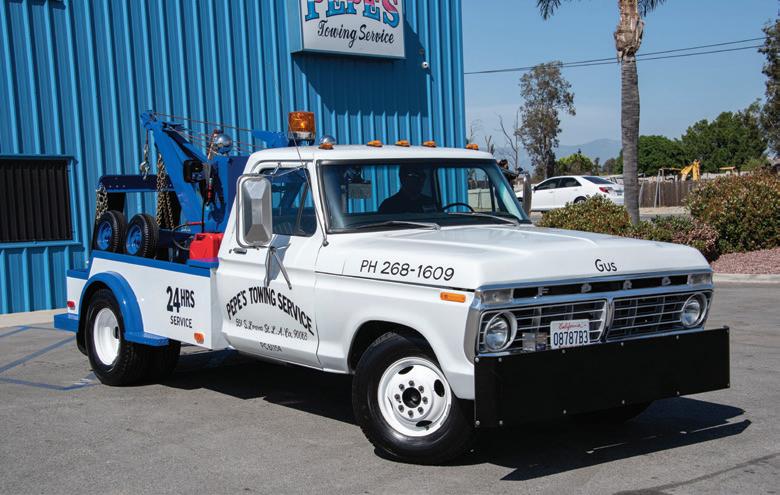

Pepe’s sons, Manny and Pepe, Jr. were young guns, though. They were willing to kick in when one of Pepe’s operators got into an accident, and they diligently helped Dad to overcome his challenges, expanding the business into a
couple of tow yards in Los Angeles and San Bernardino, running eight trucks both night and day.
With Lorenzo Navarro’s assistance (who worked with Pepe at his gas station in the 1970s), eventually they would grow to establish a total of
• May 2023 | Towman.com
ClassiC wreCker
“Because of that truck we are what we are today.”
16 yards in three SoCal counties, with 95 wreckers, including flatbeds, medium-duty trucks, and heavyduty rotators. The brands they use are diverse, including Jerr-Dan, Chevron, Vulcan, B&B, and Landoll.

Getting back to Pepe’s old soldier, the ’78 Ford, he sold it in 1985, and he passed away on March 17, 1992. Pepe, Jr. looks back fondly on those early years with his father and that wrecker.
“That was his baby and it fed us,” he reminisces. “Because of that truck we are what we are today.”
So Pepe, Jr. wanted to recreate his dad’s rig as a tribute to him and his mother Maria, for all the sacrifices they made over the years. Finding a suitable replacement was no simple task, though. A friend named John Soma scouted out an identical “wrecked wrecker” in Kingman, Arizona, but the owners, Tom and Dave Haliburda, hot rodders originally from SoCal, planned to restore it as a family heirloom, so they were very hesitant to sell.
Pepe, Jr. made a last-ditch effort in person, first saying a little prayer to himself, and then explaining, “That’s my family truck. If you just give me five minutes.”
He told Tom who he was, sharing his life
experience, and kept things personal, explaining that he wouldn’t use the Ford replacement for work or resell. It would be historical, commemorative.


Tom had never planned on getting rid of the Ford, but when Pepe, Jr. showed him some old photos and said he wanted to restore it to honor
to his dad, Tom relented.
“Pepe is godly guy, and so am I,” Tom shared. “I think we crossed paths because of that. We think highly of him, he’s just a godsend.”
Once they struck a deal, Pepe, Jr. felt a peace of mind with his dad. He brought it back home to Fontana,
AmericanTowman.com | May 2023 • 43 Stay Safe!
The Lamb PTO sling is not a common setup, but served Pepe well for many years on his original Ford wrecker. Even though this tribute truck is now for show only, its big-block Ford V-8 has plenty of grunt for towing.
◀
The cabin is plain but functional, with a Motorola radio for dispatch.
CA, and began rebuilding all the mechanicals, from the 460 big-block V-8 up front to the tailpipes. The hardest part was locating certain factory-original replacement parts. He also had California Auto Body sandblast and repaint the body to match dear ol’ Dad’s color scheme.

As promised, this recreated wrecker is now for show only,

and involved with community outreach, police charities, and holiday events for kids. The truck even made a brief appearance in a commercial with Mario Lopez to promote his Access Hollywood TV show. For Pepe, Jr., though, his truck is not about being a TV celebrity, but represents an enduring tribute to his dad.

44 • May 2023 | Towman.com
The script on the back of the cab “Dedicated in Loving Memory of Jose Pepe Acosta 1936-1992 and Maria” says it all.
The old-school rigging worked just fine for towing back in the day.

Uneasy Riders
Safety Tips on Transporting Motorcycles
By Randall C. Resch
Afull-dressed Harley wasn’t loaded using a modern-style cycle caddy, and was poorly restrained. So to no surprise, during transport it skipped out of its restraints and dropped onto the carrier’s deck, causing thousands of dollars in damages.

The tow company’s owner allegedly wouldn’t provide insurance info when the Harley’s owner sued for damages. Ultimately, once the suit was settled, Mr. Harley was the easy victor, commenting, “I won significantly more than I was originally asking them to pay, plus they had to pay lawyer fees.”

Noting this unfortunate and unnecessary incident as a basis for training, “Would the damages and subsequent lawsuit have been prevented if proper equipment, accessories and techniques were used?” Of course, so here are some recommendations.
PERSONAL PERSPECTIVE
As a big bike rider myself, I’ve had Harleys, Goldwings and motorcycle trailers transported for a bunch of reasons. As is typical when getting stuck or stranded outside some small town, the tow companies sent by my motorcycle rider’s insurance plan weren’t equipped or properly trained. Why not?
In today’s market, too much ego, avoiding extra costs and sheer stubbornness all contribute to avoidable and preventable motorcycle damages. While cocky towers say, “I don’t need no’ stinkin’ specialty gear,” savvy tow owners understand that investing in specialty equipment helps to prevent operator-inflicted damages and costly lawsuits.
Towers, take note: If you’re the responding tow operator, do you project confidence and skills that you’re capable of transporting motorcycles? That said, what is the end result of a 900-pound, $30,000 Harley, Goldwing or Beemer being dropped on its side? Is your tow truck or carrier equipped with industry-approved specialty equipment?
Since many towers ride big bikes themselves, this narrative serves a twofold purpose: one for us personally as riders, and secondly for tower’s responding to cycle requests. As a rider, would you accept services from an inexperienced operator driving a junky, oil-coated carrier having nothing more than two raggedy ratchet straps?
46 • May 2023 | Towman.com
Tow operaTor
Operations Editor Randall C. Resch is a retired California police officer and veteran tow business owner, manager, consultant and trainer. He writes for TowIndustryWeek. com and American Towman, is a member of the International Towing & Recovery Hall of Fame and recipient of the Dave Jones Leadership Award. Email Randy at rreschran@gmail.com.
Motorcycle Rescue employs customized trailers from AmeriDeck that can be loaded into a pickup bed for safe and secure transport of motorcycles.
◀
Savvy tow owners understand that investing in specialty equipment helps to prevent operator-inflicted damages and costly lawsuits.

Motorcycle Advertisers
RIDERS’ MINDSET
Modern techniques and mechanical processes are necessary to transport motorcycles, and strike at the very core of outfitting tow trucks. The big picture of risk management is something tow owners should always consider. If you’re a manager of a motorcycle rider plan, these suggestions may help raise the bar of companies serving the transport network.
Admittedly, as one of those demanding and uppity bigbike owners, I have high-expectations of tow companies when it comes to transporting my big bike. Not for a second would I allow an untrained tow operator to transport my bike.
If you provide motorcycle transport services, here are my personal recommendations that go beyond the oldschool techniques that many towers currently employ. It begins with roadside providers requiring that their network of tow operators meet a minimal standard of care as it applies to training and equipment. Different than conventional motorcycle loading techniques, consider these important best practices regarding safe transport that leads to customer/rider satisfaction.
SLICK SURFACES
Oily carrier decks often result in slip-and-fall incidents. Obviously, having only two wheels, motorcycles must remain upright and balanced. Cycles are best transported with a dolly centered on a carrier’s deck, since a tilted, 13-degree, slippery slope is a mishap waiting to happen.

To prevent this problem, “make your bed.” That means get equipment, wood blocks, rope and attachment straps prepared at four corner locations, ready to attach, before bringing the cycle to transport position. There’s nothing wrong with using as many straps as possible to prevent an unintended drop. Also, a mounted, front-wheel chock for carriers is a valuable accessory.
AVOIDING THE TIPPING POINT
Many touring riders will admit they’ve tipped their big bikes over at one time or another. When a monster, 600-plus pound bike is leaned beyond its tip-over point, there’s no stopping it. To prevent that from happening, a motorcycle dolly or cycle caddy is a four-wheeled, accessory item that allows for vertical, zero-degree positioning on the pavement before loading. Prior to being winched or rolled onto the carrier’s deck, a cycle dolly allows for the cycle to be strapped down on mostly level ground where it doesn’t require an operator or customer/rider to straddle it.

Loading motorcycles is a difficult process when tipover hazards are always present. Attempting to physically stop a tipping bike is a guaranteed way to injure one’s

48 • May 2023 | Towman.com
◀
The AmeriDeck can be operated with a wireless remote, and Motorcycle Rescue added e-tracks, and uses marring-proof straps and shop towels as well.
Be alert to avoid damage from straps rubbing on motorcycle components.
AmeriDeck...................................... Motorcycle Towing Services.......... Zip’s AW Direct................................
Note how the motorcycle dolly is centered on the deck, with four tiedowns running through the top frame and rear wheel.
see p. 72 see p. 53 see p. 51
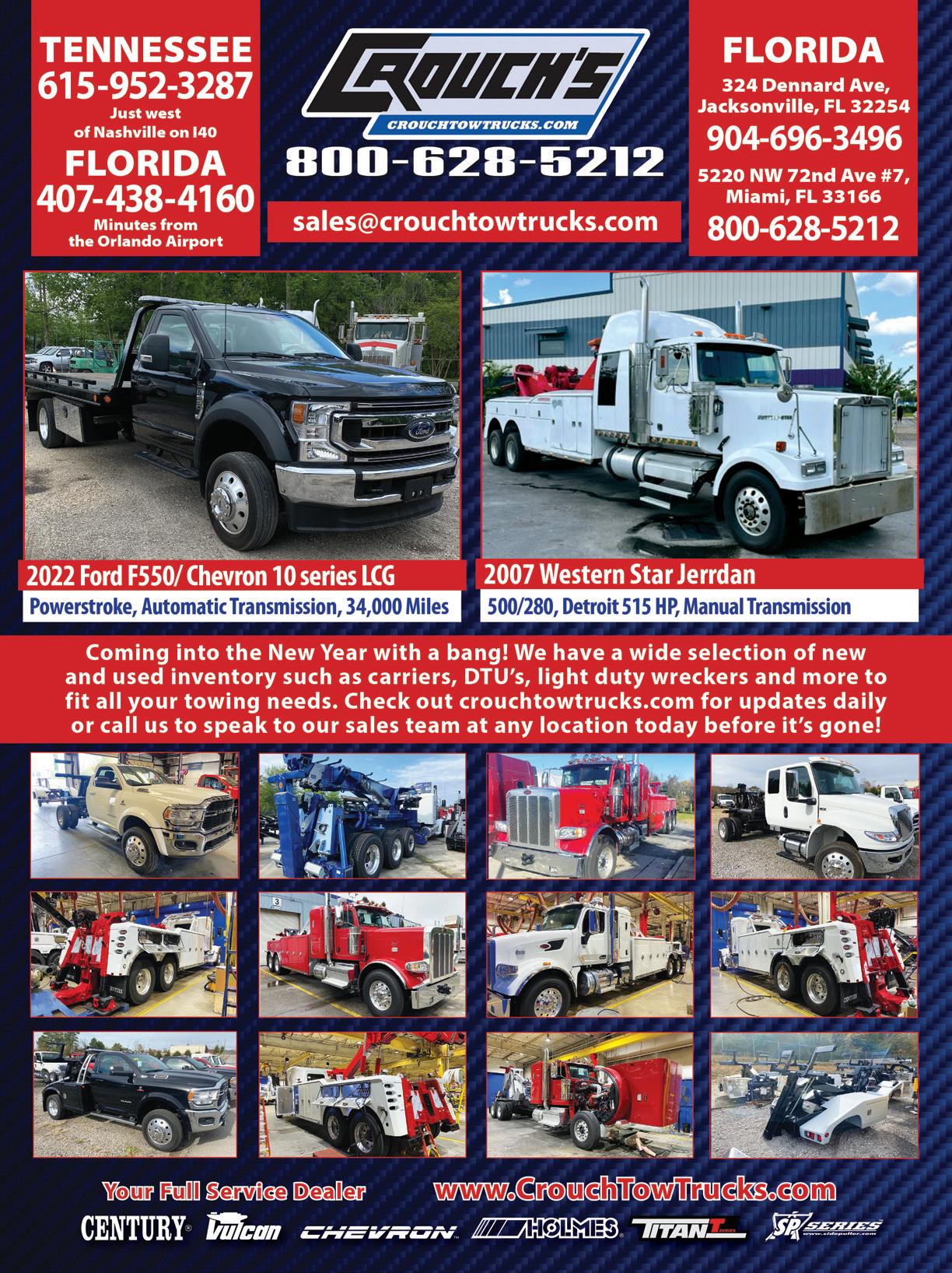
back. Invest in a cycle dolly, both for increased operator safety and ease of loading.

WHEEL-LIFTS AND WIRELESS REMOTES
Wheel lift adapter plates allow operators to load at near zeroloading angle while keeping the bike upright atop the wheel lift’s lowered boom extension. While a front-side adapter plate holds the cycle upright, the rear plate’s raised sides prevent the cycle’s rear tire from slipping off the wheel lift. Adding extension lights brings the extended load in compliance with overhang laws.
Tow trucks and carriers aren’t typically equipped with wireless controls. There’s added safety value
in having wireless controls, allowing towers to straddle the cycle during the loading process. But don’t winch from the cycle’s front forks, to avoid bending the bike’s “Triple Tree.”
When a cycle dolly isn’t available, straddling the cycle helps keep it upright while using a remote. An operator can control the tow truck’s operations without enlisting a customer/rider to run the controls or having them straddle the cycle.
CRUSTY CUSTOMERS?
Keep in mind that cycle owners can be an aggressive group who might try to insert themselves (if allowed) to “help” in the process of loading. Adding an additional person is a potential catastrophe should they slip and fall during the load process.
As one example, a short-statured, female motorcycle cop attempted to ride a tall, crotch-type bike onto a tilted carrier’s deck as the operator and her counterparts watched. While her intent was commendable, this approach did not have a happy ending, as you might expect.

Overall, the industry is wracked with lawsuits against tow companies
who asked riders to be involved in the loading and off-loading process where they slipped and fell. Bottom line: customer/riders should never be allowed to assist. When proper equipment and techniques are employed, no operator or rider should have to sit atop a cycle being winched onto a slippery, tilted carrier’s deck.
A BUMPY RIDE
Another fact to keep in mind is that flatbed carriers have stiff suspensions carrying heavy loads, and motorcycles typically weigh less than 1,000 pounds, so their lighter weight has no real effect on compressing the carrier’s suspension. It’s a well-known fact that the bumpiest ride is over the carrier’s rear-axle, so the cycle should be moved as far forward as possible towards the winch.
For additional stability, use the cycle’s kickstand during the process of tie-down. If a transport dolly isn’t available, once the cycle is brought onto the carrier’s leveled deck, the kickstand can remain lowered. Doing so is the towers matter of preference, but parking a bike on a lowered stand on the street is no different than when parked on a carrier’s deck.
When the cycle straps are released, keep the stand lowered until ready to roll to the tailboard. But remember to tuck the stand up to avoid snagging pant cuffs or snagging the stand on the deck.
STRAPPING DOWN
Jerky, bouncy travel is a sure way to skip-fall a loosely restrained cycle. Especially true to navigating turns and bumps, loose straps may not have sufficient resilience to retain the cycle’s weight causing it to break loose and fall.
Ratchet tie-downs, looped straps and soft, round slings are best suited to motorcycle operations ◀
50 • May 2023 | Towman.com
Minute Man’s front-side adapter plate holds the cycle upright, and the rear plate’s raised sides prevent the cycle’s rear tire from slipping off the wheel lift.
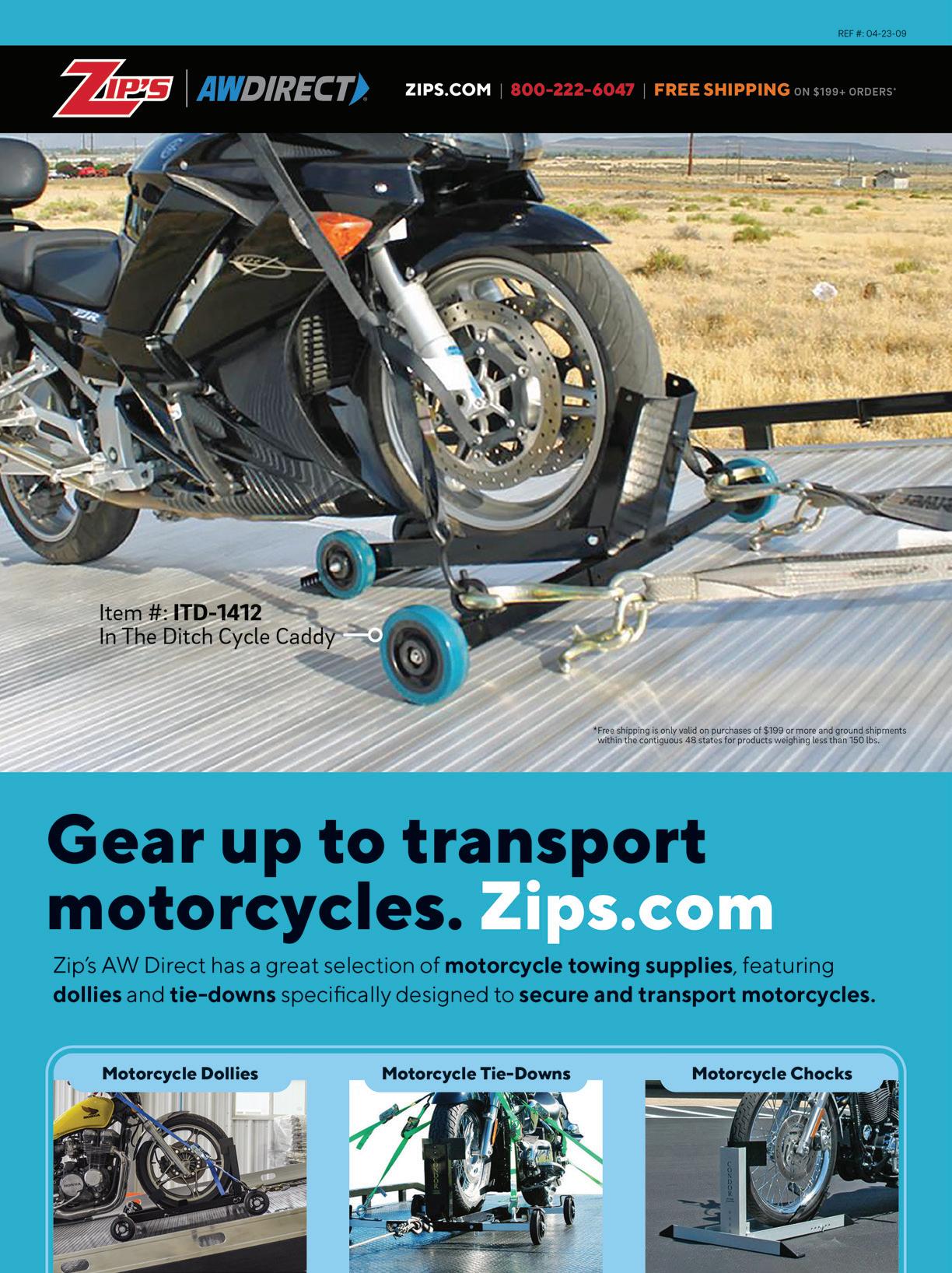
versus the weaker, oneinch, pull-style motorcycle straps. Ratchets and straps gain far better holding power and are less apt to release, while J-hooks and chains through the wheels are typical of “hacker operators” who are lazy and don’t care about damages.
In addition to bike strapping, employ a crosshandle bar harness that’s suitable for bigger bikes. Looped and cupped end caps keep straps off an extra-wide fairing’s paint. Note that a dropped motorcycle could experience a minimal $1500 repair to replace fairing components, busted mirrors, cracked valve covers and bent crash-bars, not to mention an operator being injured in the process. A twosided, strap rub on a BMW’s painted surfaces costs over $500 alone. And a single, operator-inflicted damage could cost more
Show Me the Money—in Motorcycle Transport
There’s always the question, “How much will I make transporting motorcycles, quads and three-wheelers?” Even more so, it begs the question, “Is it worth the effort and what it costs to have the right equipment?”
Also, what about those breakdowns that are a long way from the office?
Fees and surcharges vary across the U.S. and Canada based on the type of equipment being used. Some companies charge the regular rates as vehicle towing so as not to price themselves out of the market. Smart motorcyclists may select towing on their car insurance plans, or they can purchase a program from the internet. Most tow insurance coverages include 100 miles of towing, costing the rider around $90 annually. Some plans include transporting cycle trailers when attached to the bike.
Especially true to big bike touring riders and group associations, roadside services and towing might be included when owners belong to rider associations like Harley, Goldwing, and Beemer. AAA covers motorcycles as well for around $88 annually, covering 200 miles for premier members. When considering what to charge, a little comparison shopping
is a great way to learn what the market in your area will bear.

Up-charges may exist if the tow company uses a motorcycle dolly considered “special equipment.” Specialty equipment may include transport dollies, handlebar straps, soft looped-end straps, and conventional trailer balls. When equipment is fancy like Ameri-Deck’s pickup truck bike transporter, charges may be higher as these providers could be “motorcycle only” companies who aren’t conventional tow truck companies. Towers should note that an insurance plan may not pay your commercial rate, so be sure to negotiate (and agree to) what “allowable rates” the insurance plan will pay. These rates don’t apply should a motorcycle be involved in a traffic collision and is towed as the result of a police request (then police rates would apply).
Like transporting exotic cars, it’s important to realize, “risk over reward.” Unless you transport motorcycles in and around places like Sturgis, Daytona’s Bike Week, or other big bike rallies, motorcycle transport shouldn’t be considered a get-rich scheme. But it certainly can add to a company’s bottom line.
52 • May 2023 | Towman.com
than the initial purchase price of a quality bike. So be sure to pad “S-Hooks” that tend to scratch chrome parts if not attached properly.
MORE TOW BUSINESS
When dealing with discriminating motorcycle owners, a well-trained and well-equipped tow truck or carrier can generate repeated business, plus it reduces the risk of tip-over scenarios.

On the other hand, if you’re a fellow rider, you have choices. Before your insurance plan dispatches an unknown company to you, opt to get their contact information and ask important questions related to the best interests of your cycle.
For towers, specialty cycle equipment and accessories are readily found via the Internet and tow equipment suppliers. Combined with proper training and a tower’s damage-free mindset, towers can provide motorcycle services above and beyond that of their competitors.
If you think I’m partial to having my Goldwing transported with the right equipment, you’re right! When it comes to good, better, and best risk management, today’s upgraded equipment helps to ensure best practices when providing motorcycle services.

AmericanTowman.com | May 2023 • 53 Work the non-traffic side - Stay Safe!
Tow Dollies Do’s and Don’ts
Safe Handling Tips to Avoid Injury
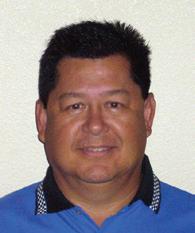 By Terry Abejuela
By Terry Abejuela
Most wheel-lift and conventional tow-sling trucks are equipped with a dolly that allows for towing vehicles when all of the wheels must be off the road surface during transport. Such as when the towed vehicle has four flat tires, the wheels are locked up, there’s collision damage, or with allwheel drive, four-wheel drive, and electric and hybrid vehicles. Tow dollies also can be used to avoid transmission damage or create additional ground clearance on lowclearance vehicles.
When car carriers came on the scene, tow operators would often call for them rather than placing a vehicle on a tow dolly. Yet, some situations may be more effectively and efficiently handled with a wheel-lift or tow-sling truck and a set of tow dollies. Low-clearance garages or tight parking lots are just two examples where a wrecker with tow dollies may be more appropriate. If a tow operator arrives on scene in a hazardous situation such as a freeway call, it may be safer to load the vehicle on dollies rather than wait on a freeway for a car carrier.
Several types of towing dollies are now available, but the type most towers are familiar with today is the self-loading type, so this article will focus on storage options and safe use of this particular one.
CLOSE EXAMINATION
Make sure you are familiar with the manufacturer recommendations for the inspection, maintenance and proper use of the towing dolly being used. Most manufacturers have videos and operations manuals available for their products. The two most common self-loading tow dollies used in the towing industry are the Collins Hi-Speed Dolly and the In The Ditch X-Series Dolly. The dolly loading procedure described in this article is for the Collins Hi-Speed Dolly.
Tow dollies should be inspected at the manufacturers recommended intervals to ensure all parts are in good working order and free of any damage. Keep moving parts properly lubricated so that they function properly and provide extended service life, and maintain the proper air pressure in the tires and inspect them for wear, including the valve stem.

LOCATION TIPS
There are many storage options
54 • May 2023 | Towman.com
haNds-oN TeCh
Field Editor Terry Abejuela has 40-plus years of light-duty towing and recovery experience. He is also a light-duty Level 1 instructor for the California Tow Truck Association.
◀
Be familiar with all of the safety and mechanical features of a dolly before use.
When purchasing tow dollies opt for all of the weight-reduction features available.


AmericanTowman.com | May 2023 • 55 Work the non-traffic side - Stay Safe!
available for self-loading tow dollies. One of the most common used today is the dolly bunker mounted under the wrecker bed. This option is convenient and does not take up valuable space on the wrecker deck, however some bunkers leave the dolly exposed to the elements. If you have this type of storage, it is critical to inspect the dollies often, especially during bad weather.
When choosing a storage option, take into consideration accessibility, security, weather protection and operator safety, and choose an option that minimizes the potential for operator injury. Even though modern tow dollies are lighter weight than older versions, they are still a significant amount of weight for a tow operator to lift from an awkward position.

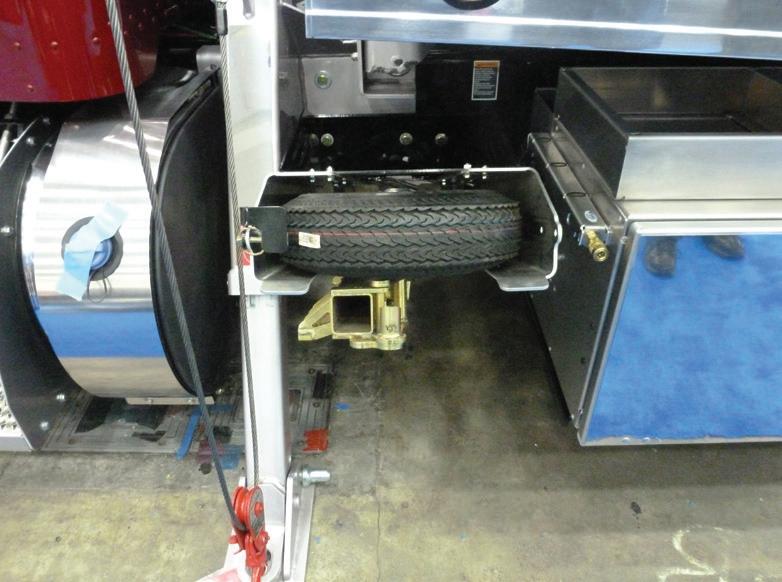
Avoid mounting options that require the tow operator to climb on the truck or lift from higher than waist height. Dolly bunkers under
the bed, gas-shock assisted brackets, and drop-down storage boxes are all practical options.
In addition, when purchasing tow dollies, opt for all of the weight-reduction features available. Aluminum dolly axles can weigh half that of steel axles. Even with reduced weight and ergonomic storage options, tow truck operators should use good lifting technique to avoid injuries. Use your legs with your back straight as much as possible, and avoid carrying the heavy parts to the disabled vehicle. Whenever possible, roll the dolly frame to the disabled vehicle instead of carrying it.
GETTING ATTACHED
Before loading a vehicle on the tow dolly, attach the towing device to the vehicle but do not lift it, as this will ensure the vehicle cannot roll away once it is loaded on the dolly. If the vehicle is lifted, some weight will transfer from the lifted end
of the vehicle to the opposite end, which would then have to be lifted using the dolly pry bar.
Place a dolly frame on each side of the axle to be loaded with the dolly in the unloaded position where the frame sits on the ground. Then adjust the width of the dolly axles to the appropriate width of the vehicle to be loaded. Both axles must be the same length.
Use a screwdriver to depress the spring-loaded dolly axle locking pin. The axle should be extended enough to extend just past the outside edge of the disabled vehicle’s tires. Don’t extend the axle more than is required. Place one dolly axle in front of the tire and one behind the tire with the wheel tabs facing the tire.
Place one dolly axle tab on the edge of the dolly axle into the dolly axle pocket on the dolly frame. Place the opposite side of that axle in the matching dolly axle pocket on the opposite side of the vehicle. Once one dolly axle is installed in the dolly axle pocket on the dolly frame, roll the dolly frame toward the tire so that the axle is snug against the tire. Repeat this process with the second dolly axle on the other side of the tire. When installing the second axle, place it as close to the tire as possible without forcing it in.
Engage the safety ratchet system by rotating the cam handle 180 degrees so that the ratchet is engaged with the gear teeth. Failure to properly engage the ratchet with the gear teeth can result in personal injury during the loading process.
LEVERAGING OPERATIONS
Insert the dolly pry bar into the dolly pocket and move the pry bar in a full arc to raise each dolly wheel to the fully loaded position. You should hear the clicking noise as the ratchet engages each tooth in the gear. Engage the safety lock on the trip handles, and
56 • May 2023 | Towman.com
Dollies are a valuable piece of equipment for car carriers on a low-clearance vehicle or when its wheels are locked or damaged.
To avoid back injury, aluminum dolly axles are preferred over heavier steel axles.
avoid placing any part of your body in the path of the pry bar. Keep both hands firmly on the pry bar to pull the pry bar towards you instead of pushing it away from you. That way, in the event the ratchet system fails and you lose grip on the pry bar, the tension on the pry bar will move it away from you instead of toward you.
FINAL SETUP AND UNLOADING
Once the vehicle is in the loaded position on the dolly, secure both wheels of the loaded vehicle to the dolly with wheel straps. Raise the towing device to the appropriate towing heights, install safety chains and tow lights. Do a walk-around inspection to ensure you have properly completed all steps to safely tow the vehicle.
To unload the vehicle from the tow dolly, leave the vehicle attached to the towing device, but lower it to the ground before attempting to unload it from the tow dolly. Remove the wheel straps and disengage the safety ratchets.



Then insert the pry bar into the pry-bar pocket. Keep one hand on the pry bar and apply enough downward pressure to keep the bar from raising while disengaging the lock on the trip handle. Lift the pry bar just enough for the spindle to clear the trip handle, and then place both hands firmly on the pry bar. Stand where the pry bar will move away from you and slowly lower the dolly to the ground. Repeat this procedure on the remaining three dolly wheels.
Lastly, disassemble the dolly and use good lifting technique to place the dolly parts back in the designated storage locations. The tow dolly loading procedure described in this article applies to the Collins Hi-Speed dolly under normal circumstances when the disabled vehicle has properly inflated tires. Other styles of self-loading tow dollies, traffic conditions, vehicle condition, flat tires, or lack of wheels may require special procedures.
AmericanTowman.com | May 2023 • 57 Work the non-traffic side - Stay Safe!
When choosing a dolly storage option, consider its accessibility, security, weather protection and operator safety.
Balancing Act
Simple Tips to Running a Family Business Smoothly
By Chase Clough
Life as a tower is admittedly difficult, juggling late-night recoveries with basic necessities like eating and sleeping. Then add to that some challenges when working with your loved ones in a family business. Since you’re with them not only at work but also at home, it’s important for everyone to have clear boundaries and expectations.
As a case in point, Charlie and Debbie Entwistle, owners of Entwistle’s Garage in Leicester, Massachusetts, have been carrying on a family legacy for 75 years and counting. So, they are real-world experts at balancing business and family and shared some tips on how to successfully run a family business.

FOCUS ON THE UPSIDE
managing the money,” Charlie notes. Whether handling the business books or working the front desk, Charlie knows he can always count on his family to get the job done. Another positive of working with family is the fact that you already know them. You don’t need to conduct extensive job interviews or background checks.
CLEAR RESPONSIBILITIES
When you have multiple family members in your business, the lines between jobs might start to blur.
“You should have a concrete definition of what their role is in the business,” Charlie advises. “And have honest expectations for their role in the future.”
Chase Clough of Drive has a wide range of marketing experience with writing, editing and content creation across all social media platforms. Her recent marketing positions include Florida State’s Career Center, and she is now a master’s candidate at Florida State University. Chase uses these skills in her position at Drive based in Monrovia, CA.

There are many positive aspects of a family business, most importantly you get to work with the people who you care about the most. Entwistle’s Garage was founded in 1947, and purchased by Charlie and Debbie from Charlie’s father in 1990, and they have been running it together ever since.
“The upside of working with family is the ability to trust them completely when
So, make sure to clearly spell out each person’s job. This way, no one trades responsibilities with one another, and everyone knows exactly what they are supposed to do. While job responsibilities could well change as time goes on, they should be clear to you, the family member, and the other people working at your company in order to minimize any confusion.
58 • May 2023 | Towman.com
BeaCoNs oN!
Entwistle’s Garage in Leicester, Massachusetts has been successful in carrying on the family legacy for more than 75 years.
START ‘EM YOUNG
The key to preparing your family to work in the business is to make sure they know what they are getting into. When you bring your children to work with you, they can start building a knowledge of the business early. By being able to see what owning and operating a company is truly like, they can get a reality check on whether or not they want to join in. Charlie says he started working in the business after school when he was 13, and he had his kids do the same.

SHOP TALK

Whether you live with the other family members

AmericanTowman.com | May 2023 • 59 Work the non-traffic side - Stay Safe!
◀
Successful family businesses require good communication.
Family Matters
Personal Experiences of a Tower’s Daughter
By Farah Whittenberger
As the daughter of American towman Bryan Whittenberger of Hitch ’n Haul, I know firsthand that the job is not always just towing, but also includes roadside repair, in-shop repair, or hauling a load. There are many privileges to being the daughter of an American towman, but with privilege comes sacrifice, such as when we both miss special time with family and/or events.

Never knowing who or when an individual will call for a tow or roadside help, towers aren’t able to live on a set schedule, especially if you are the owner of a towing and service company. Every customer call has the potential to change what an employee does for the rest of the day.
I know firsthand what it is like to work on the side of the road. Beginning when I was about five years old, I would go on road calls with my dad, Bryan. I would stay in the truck and watch him work. I was surprised by how strong you need to be to lift a tire, and the skills required to rewire a trailer, fix airbags, air leaks, lights, and more.
When towmen jump in their vehicle, they are at risk. Concerns about losing a parent or sibling are normal in the towing and service industry, no one is alone in that feeling. Like a policeman who patrols the streets, or a fireman who enters a burning house, towers too, face hazards. A primary concern of towers is working by themselves on the side of the road.
They often play a critical role in the safety of drivers on the highway. Traits needed by an American towman are intelligence and bravery and without them, the cleanup of incidents and recoveries would fall far short. I am proud of my father because I know he helps other people daily.
As the sixth of seven siblings (five girls and two boys), with my eldest brother and older sisters also playing a role in the towing industry, we put the “family” in the family business. When I can’t sleep, I
will call my brother Dakota, who works the second shift, and ask to go with him on a call. On the way to the job site, we sing along to the radio and laugh about some of our childhood memories. This helps me a lot, as on the way back I am tired and can finally sleep.
There are many more privileges to being part of a towing family. I learned how to operate forklifts, skid steers, truck and trailer units, as well as many other tractors. I find driving fun and cannot wait to get my driver’s license. I also know how to change a boat battery, charge a car battery, and do jumpstarts, along with changing and airing up a tire, and understand how to navigate and recognize landmarks. These skills will be useful when I get older, leave for college and get a vehicle of my own.
On the other hand, when you are a child of an American towman, there’s always that one person on the side of the road whose car battery happens to die during your special occasion or on a holiday, so dad is inevitably late to the big feast. But sometimes he will bring an extra person with him. My family and I have shared many dinners with stranded truck drivers and even our employees, creating warm memories and stories to tell.
Being a true American towman and a generally good person requires compassion, along with the ability to communicate with every customer, friend, and family member. This quality is needed for understanding the people we take care of and the services we offer. My father has brought many customers to our home to share a healthy meal and show compassion when an unplanned breakdown or layover may take days, which might prevent the customer from enjoying a holiday or special occasion with their own family.
When people’s vehicles break down, they feel vulnerable and need to trust that they are in good hands. When a towman arrives on the scene and turns on his big flashing lights, the person needing assistance can finally feel safe and talk to someone who can help them in a meaningful way. This is the life of an American Towman.
60 • May 2023 | Towman.com
Farah Whittenberger with her dad Bryan, owner of Hook-N-Haul Repair & Towing in Litchfield, Ohio, and strong supporter of APTO (Association of Professional Towers - Ohio).
that work in your business or not, it’s important to have clear guidelines set in place for shop talk. Maybe you have a rule where you and your spouse can’t discuss company issues during designated family time, such as at the dinner table. Having these boundaries in place can make sure your work and family life remain separate and balanced. Charlie says his wife Debbie has rules in place for when they can and cannot talk about work and it helps keep the peace.

ONLY IF YOU WANT TO
When you have owned and operated a family business for a long time, some family members may feel like they must join the team. As Charlie puts it, “Make sure the other family members really want to be there, rather than being there from a sense of obligation.”

If your family members feel like they have to work in the business, it could make them resentful. When no one feels like they are obligated to
work in the family business, it’s likely that they will be more motivated to fulfill their role and continue the family tradition. ◀
AmericanTowman.com | May 2023 • 61 Work the non-traffic side - Stay Safe!
COUNT YOUR BLESSINGS

Taking time out of your busy schedule each day to focus on what makes you thankful can help keep you on track. You might want list all of the reasons why you appreciate being a business owner, such as how you get to make the decisions, control your own schedule, and do what you love.
Also, list all the reasons you love your family, both in general and when you work with them. Examples include; how you know them better than anyone else, your innate trust in them, and how you get to experience each day being in the company of your loved ones. When you’re mindful of why you love every aspect of your job, you’ll likely enjoy every day of work. Charlie says he prefers running his family business for two main reasons. “For one, it makes me proud that I can carry on my dad’s dream,” and, “Second, it gives me more sense of security than working for someone else.”
NEARING THE END OF YOUR TRAIL
Working with family means different family members might have varied expectations on what will happen to the business once you step down. It’s important to talk to everyone about the future, to make sure everyone is on the same page. You will also want to have your exit strategy written down. When you’re open and honest about what you plan to do, or who you plan to pass the business on to, your family members will feel valued and connected to you.

Planning ahead also allows for them to plan their future at the same time. (Maybe someone who you thought would continue your legacy is happy to remain as any employee instead of an owner.) Clear communication will ensure a smooth operation now, as well as an easier transition when the time comes.
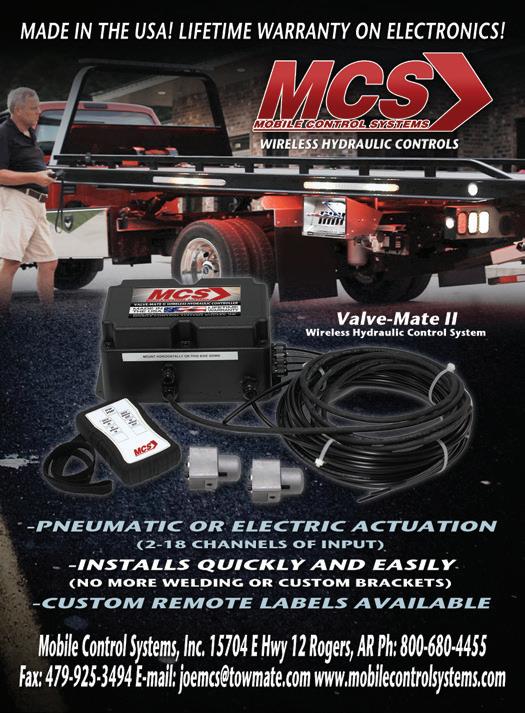
62 • May 2023 | Towman.com
Read more towing news at towman.com Find us on Facebook

Cummins Introduces New Engine Technology
In March, Cummins announced the launch of Accelera by Cummins, representing the company’s commitment to playing a major role in the hydrogen economy. This new brand represents the quick pace of bringing zero-emissions solutions to market. Cummins’ initiative will focus on three key areas: the production of green hydrogen, the management and transportation of hydrogen, and the application of hydrogen in engines and fuel cells. The latter uses oxygen to create a reaction, turning hydrogen into electricity, it will work alongside the current battery technology.
In other news, Cummins is launching the next engine in the fu-
el-agnostic series, the X10, in North America in 2026. Named as part of the X engine family, this new engine is uniquely positioned to replace both the L9 and the X12 with the versatility to serve both medium and heavy-duty applications. It will also be compliant with U.S. EPA’s 2027 regulations a full year early.
The diesel version will be available first, with other versions for gaseous fuels introduced later. Cummins officials said diesel will remain a critical technology for the commercial vehicle market for years to come. The 10-liter displacement product slots into Cummins’ product portfolio complemented by the B6.7 and X15 and will serve vocational, transit, pickup and delivery, and regional haul customers.
The X10 diesel powertrain in-
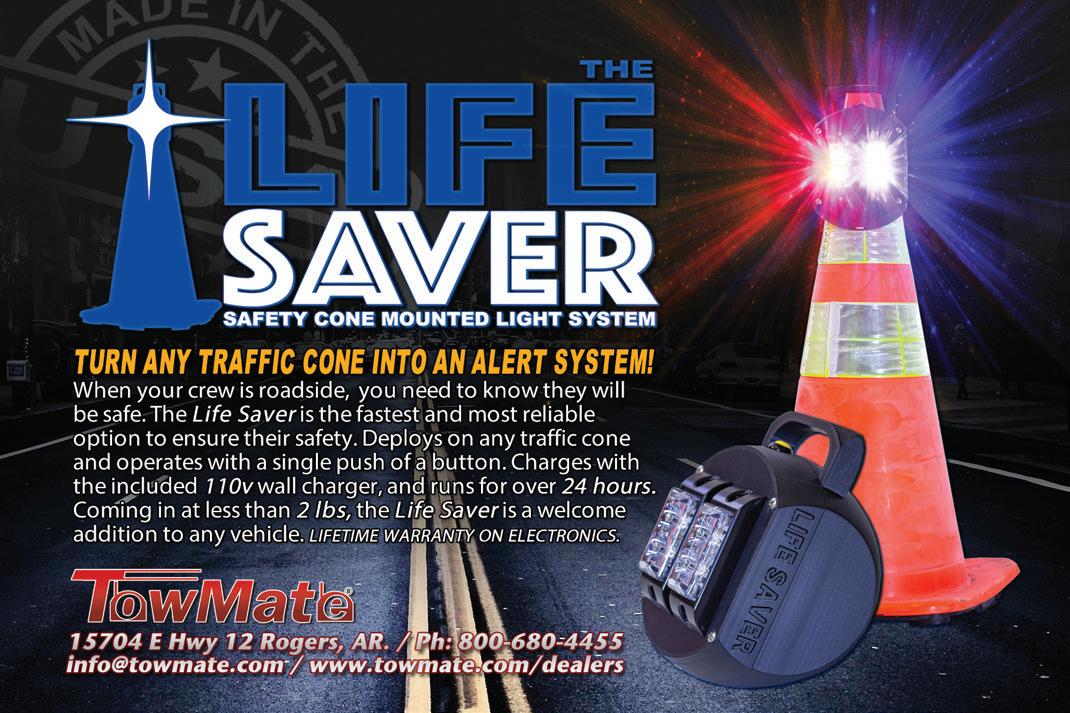
creases fuel efficiency while decreasing greenhouse gas and NOx emissions to comply with the stringent EPA 2027 regulations. In addition, the X10 will be a common platform that works across multiple fuel types for internal combustion engines.

These new fuel-agnostic engine platforms feature a series of engine versions that are derived from a common base engine, which means they have some parts commonality. Below the head gasket of each engine will largely have similar components, and above the head gasket will have different components for different fuel types. Each engine version will operate using a different, single fuel.
Cummins is offering a full portfolio of products in 2026 to cover the medium-duty and heavy-duty customer needs, including the new 15-liter natural gas engine, the X15N. Additionally, the B6.7 will be offered in diesel, natural gas, gasoline, and propane.
64 • May 2023 | Towman.com
supplier sCoop
Hydrogen-Fueled Ford Super Duty Trucks
Ford is developing more applications of hydrogen technology. A recent publication by the European Patent Office showed a patent for mounting a hydrogen fuel cell vehicle’s tank. Ford’s under-floor tank is made up of two parts: one portion slides out to increase capacity as the tank is filled; and the other portion slides back in as the tank drains. This design is intended to keep the hydrogen pressurized at appropriate levels, and appears to be applicable to the box frame chassis used in the F-250 Super Duty FCEV.
Other indications of Ford’s interest in hydrogen include a turbocharged combustion fueled with hydrogen. Why hydrogen when Ford already has electric vehicles (EVs) in production? As noted in our previous issue’s Supplier Scoop, they are not yet practical for towing, as Ford CEO Jim Farley readily admits,
especially for Super Duty customers. He pointed out that, “…95 percent of our customers tow more than 10,000 lbs. This is a really important segment for our country, and it will probably go hydrogen fuel cell before it goes pure electric.”
Work Truck Reference
The latest version of NTEA’s Truck Equipment Handbook (16th edition) is now available. This guide for commercial vehicle components and equipment includes updates to U.S. and Canadian regulations, along with an expanded set of industry definitions. This edition also covers the vehicle certification process and regulatory standards applicable in Canada. The Handbook includes:
-Fundamental concepts and selection of chassis frames, PTOs, tires and other commercial vehicle systems
-Vehicle weight analysis methods, calculations and illustrations
-Advanced fuels and vehicle technology descriptions

-Reference sections on vehicle certification and Federal/Canadian Motor Vehicle Safety Standards
-Glossary of truck equipment industry terms
Cost: $15 NTEA members/$29 public
Source: ntea.com
GM Names Tenneco a 2022 Supplier of the Year
General Motors recognized Tenneco as a 2022 Supplier of the Year in early April. This award is for global suppliers that distinguish themselves by exceeding GM’s requirements, in turn providing customers with innovative technologies and among the highest quality in the automotive industry. This is the sixth consecutive time that Tenneco has received the Supplier of the Year award, and fourth consecutive for Tenneco’s Powertrain business group.
AmericanTowman.com | May 2023 • 65 Work the non-traffic side - Stay Safe! ◀
Tenneco Powertrain’s 2022 Supplier of the Year Award is for outstanding performance in the category of Connecting Rods and Pistons, which includes Tenneco’s pistons, rings and bearings components. Tenneco Powertrain is a leader in design, coatings and advanced materials along with proprietary processes that contribute to lighter, more compact engines with higher performance, greater efficiency and durability to reduce emissions and improve fuel economy.
Gains in Heavy-Duty Truck and EV Market
According to the report published by Allied Market Research, the global the heavy-duty truck market is estimated to manifest a CAGR (Compound Annual Growth Rate) of 4.8% from 2022 to 2031. The report provides an extensive analysis of changing market dynamics, major segments, value chain, competitive
scenario, and regional landscape. This research offers a valuable guidance to leading players, investors, shareholders, and startups in devising strategies for the sustainable growth and gaining competitive edge in the market. Factors such as high payload capacity, greater availability of credit and financing options, and improvement of road infrastructure supplement the growth of the global heavy duty truck market.
Based on region, Asia-Pacific held the largest share in 2021, contributing to nearly two-fifths of the global heavy-duty truck market share. Leading market players of the global heavy duty truck market analyzed in the research include PACCAR Inc., Isuzu Motors Limited, Eicher Motors Ltd, Tata Motors, Ashok Leyland, NAVISTAR, INC., China National Heavy Duty Truck Group Co., Ltd, Freightliner, Scania, MAN, Dongfeng Commercial Vehicle Company Limited, and AB Volvo.
In comparison, Allied Market Re-
search published a report on the electric commercial vehicle market, and it generated $43.5 billion in 2021, and is anticipated to generate $558.4 billion by 2031, witnessing a CAGR of 29.9% from 2022 to 2031. Based on vehicle type, the bus segment held the highest market share in 2021, accounting for more than four-fifths of the global electric commercial vehicle market and is estimated to maintain its leadership status throughout the forecast period, owing to increasing government initiatives for electrification in public transport service. However, the heavy-duty truck segment is projected to manifest the highest CAGR of 33.3% from 2022 to 2031, owing to an increase in demand for heavy-duty trucks from the automotive and logistics sector, reduction in fuel & maintenance costs, and incentives for adopting zero-emission vehicles.
Source: alliedmarketresearch. com/request-sample/32331
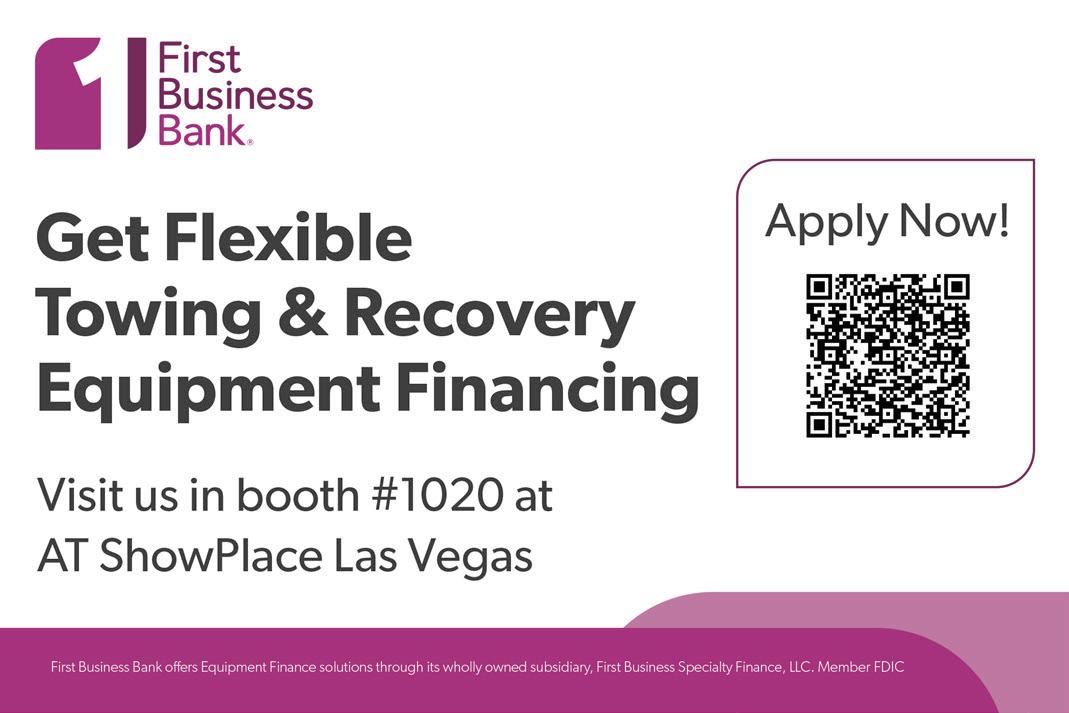
66 • May 2023 | Towman.com
Commercial Vehicle Stats
Work Truck Solutions, an authority on commercial vehicles, released its Q1, 2023 Commercial Vehicle Market Analysis. The slow but steady increase of inventory available from Original Equipment Manufacturers (OEMs) is affecting commercial vehicle sales in predictable ways.
Inventory
• With Ford leading the charge among OEMs, new on-lot inventory per dealer continued to grow: +10.8% QoQ and +46.4% YoY.
• With new inventory levels still only 46.3% of what they were in 2019, used vehicles continued to help fill the demand, as evidenced by the rise in used on-lot inventory per dealer, up 125.4% YoY.
Prices
• Average used vehicle prices continued their modest decline: down 1.7% QoQ and 4.3% YoY.
• Continuing the trend we’ve seen since Q2 2022, both new work trucks and vans still carry a signifi-
cant price tag with prices increasing 2.4% QoQ and 4.1% YoY.
• Within new vehicle averages, Empty Cargo Vans by themselves showed no signs of stagnation with prices rising:
◊ 5.0% QoQ and 5.8% YoY for Light duty work vans, and
◊ 1.6% QoQ and 7.8% YoY for Medium duty vans.
• The prices of Service Trucks also continued their upward trend with:

◊ Light duty up 1.9% QoQ, and 6.9% YoY, and
◊ Medium duty up 1.5% QoQ and 6.0% YoY.
The median mileage of used work trucks and vans maintained its upward arc, with increases of 6.3% QoQ and 11.6% YoY. Although the combination of higher mileage and more available new vehicles is influencing the decrease in used-vehicle prices, unmet demand is slowing that decrease. There is a slight increase in days-to-turn that
shows both new and used inventory staying on dealer lots longer, a trend worth keeping a close eye on in the coming months.
“An interesting note in this data is that even with higher new-vehicle prices, searches for new trucks and vans remained strong, demonstrating that customers are still dependent on replacing, and adding, vehicles for their businesses,” said Aaron Johnson, CEO of Work Truck Solutions. “On the other side of the equation is an uncertain economy, inflation, and rising interest rates. Taking all of this information in aggregate means the commercial vehicle industry is likely moving into not only a more competitive phase, but [also] a world where digital tools help buyers with acquisition…” As examples, he claims that CV Showroom and EZ Order are necessary for dealerships to thrive, and they use data-driven insights to position themselves as business partners rather than mere vendors.
AmericanTowman.com | May 2023 • 67 Work the non-traffic side - Stay Safe!





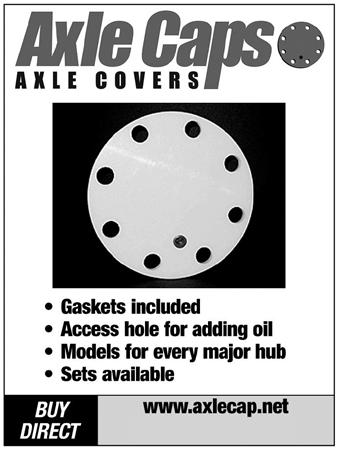




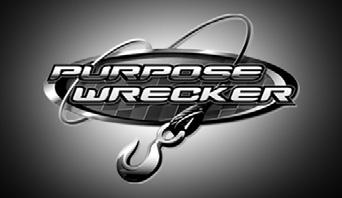


Towman’s markeT 68 • May 2022 | Towman.com Cycle friendly. Operator safe. Hauling made easy. With an Amerideck™, you can drive your motorcycle onto the platform, safely hoist your load into your pickup truck and drive away with ease. 2500lb load capacity Authorized Dealer: Aumsville Equipment Sales TruckDecks.Pro skip@truckdecks.pro 866.994.3473 503.749.1601 TOWKING NETWORK Dispatch Dedicated towing dispatchers for night, weekend and holiday service. $6 per Hour Special Introductory Offer 562-306-5107 2018 Pete 337 Jerr-Dan Carrier 2012 Dodge 5500 4x4 Vulcan Carrier SPECIALTY VEHICLE & EQUIPMENT FUNDING GROUP CNadolny@easternfunding.com 646.723.6393 Craig R. Nadolny www.towlog.com VEHICLE STORAGE LOG Commitment Service Knowledge info@travisbarlow.biz www.travisbarlow.com Call today for a free quote 800-537-7152 Specialized Insurance for the Towing Industry To Advertise In Towman’s Market CALL 800-732-3869 Ellen Rosengart x 203 erosengart@towman.com

Monumental Wrecker
A Rolling Tribute to Fallen Officers
By Steve Temple
Photos courtesy of Timothy Alsbrooks, TA Visuals
HBL Towing & Recovery has worked hard to earn a good reputation with the law enforcement community in Dallas, Texas. Since this firm joins forces with the police department on a daily basis, HBL wanted to show its ongoing commitment to law enforcement
and to honoring the lives of fallen officers. A deeply tragic event came to mind involving a mass shooting back on July 7, 2016, as an example of the heroism and sacrifice shown in heart of the Dallas community. This Century 1075S was recently wrapped with somber graphics that serve as a remembrance of the loss that five families suffered on that terrible day. Theses graphics also serve as a sad recognition of many other families that have suffered both before and since then. The hope is that this tow truck will help bring awareness to their sacrifices.

“We are very grateful to the families of the officers that trusted us with the honor of remembering their family members in this way,” stated Joseph Fitzhugh, operations manager for HBL. “I also want to thank Kristin Lowman, with the City of Dallas and Officer Jon Lumbley, with DPD for helping us organize
FALLEN OFFICERS
From the Dallas Police Department and Dallas Area Rapid Transit:
DPD Senior Cpl. Lorne Ahrens
DPD Officer Patricio Zamarripa
DPD Sgt. Michael Smith
DPD Officer Michael Krol
DART Officer Brent Thompson
this project. Thanks also to Officer Ronald Lindsey, with DART Police for his assistance. Finally, we’d like to thank Dallas Police Chief Eddie Garcia, and City Manager T.C. Broadnax, for giving permission for this project to happen.”
HBL Towing & Recovery has been providing towing in Dallas and its surrounding areas since 2010. This family owned-and-operated company was founded with nearly 18 years of transportation and realestate experience, and has grown from a single truck in 2010 to a massive fleet of various types of tow trucks and service vehicles handling
70 • May 2023 | Towman.com
My BaBy
a wide variety of challenging jobs.
HBL’s fleet consists of 65 pieces of equipment with snatch trucks, light-duty flatbeds, heavy-duty tandem-axle flatbeds, heavy wreckers, rotators, three-axle Landolls, excavators, bulldozers, dump trailers and forklifts. Just this year the company added six new heavy wreckers and four light-duty flatbeds through a local dealer, EdgeTec. ◀


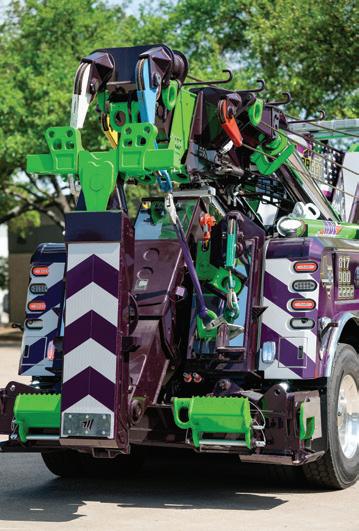
Theses graphics also serve as a sad recognition of many other families that have suffered both before and since that tragic day in July of 2016.

AmericanTowman.com | May 2023 • 71 Work the non-traffic side - Stay Safe!
HBL has grown from a single truck in 2010 to a massive fleet of various types of tow trucks and service vehicles, 65 in all.
The 2022 Peterbilt 389 runs a 565hp Cummins X15 cranking out 1850 lb/ft torque through an 18-speed transmission.
HBL’s Century 1075S box is a threestage wrecker with outriggers, a 50,000lb drag winch and dual 22,000lb turret winches.
TECH HIGHLIGHTS
Truck: 2022 Peterbilt 389

Engine: Cummins X15; 565 hp, 1850 lb/ft torque
Transmission: 18speed.
Chassis: Twin-steer tri-axle
Wrecker body: Miller Century 1075S box, three-stage with outriggers, a 50,000lb drag winch and dual 22,000lb turret winches, plus accessories selection offered by Miller Industries

Graphics: Artworks Commercial Graphics
HBL says it has accomplished this growth by maintaining strong commitments to local communities and companies and also by investing in modern technology and techniques to provide the most effective and efficient services possible to its customers. HBL believes commitment is an act, not a word, and this monumental wrecker is rolling proof.
72 • May 2023 | Towman.com

Discipline—Between the Sexes
By Steven Calitri
The American Towman company has been blessed with a team of smart, personable women dedicated to making the magazine and its expositions shine. Our reputation continues to grow from their hard work. Our rapport with tow bosses and suppliers is strong through their authentic personalities, alongside the quality of our service to this industry.
In a time when good tow operators are hard to find and keep, a tow boss would do well to assess the makeup of his company. These questions might be asked:
Does the atmosphere around the tow yard foster human dignity? Are employees generally spoken to with a respectful tone?
Are there women currently working in the office who are friendly and fun?
Would a man or woman just hired feel a warm welcome at your company?
Do your recruitment efforts reach out to women as well as to men?
Is there a company culture of doing one’s work thoroughly?
A successful professional team is a mix of various personalities and sources of intelligence. When they all pull on the same rope, they form a dynamic force. The success of the business flows out of that force.
The business, however, becomes more than just a business.
it becomes a well of activity that provides a vital meaning to their lives. A meaning that helps fulfill their human needs.
I cannot say if women take a more disciplined approach to their work, whatever it is, than their male counterparts. From my experience, they seem to be more inclined to focus in and follow through on their tasks than men do. This may be generally true. It may be that women generally are more inclined to accept their station in life at the moment than men who may be more challenged to find interest in their jobs at hand. By the way, I have had men working for this company who have been highly disciplined and productive. What are your experiences?
Zeroing in on traits of discipline among job candidates is most important to finding someone who will contribute to your company’s success. How can you detect if an applicant exercises discipline of any kind?
Find out not only about jobs they have held, but pastimes they enjoy. A person who paints landscapes or portraits as a hobby shows more discipline in their makeup than one who only watches television. Someone who likes to read books exhibits more discipline than watching television, as one’s mind must engage with the written word, where watching TV is a more passive activity.
Likewise, someone who enjoys cooking and following recipes shows more discipline than someone who eats a lot of frozen dinners.
to perfection takes more focus and discipline than being inconsistent in the manner the burgers are cooked. So, talking to a job candidate about one’s experience in a low-level function can be enlightening as to how that person goes about his work.
In whatever jobs the applicant has had, how much did he or she pay attention to detail? Find out by asking the simple question: “What are the details involved with performing that job, or that task?” A detailed answer is a good sign you have a conscientious worker applying at your company.
I asked AT’s female publisher, Dennie Ortiz, what has been her experience over the years working with men and women. Here’s what she said:
“In any administrative capacity, women prove to be more detail oriented than the men, and have better organizational skills.”
Indeed, Dennie rose up through the ranks of American Towman in large part due to these same attributes.
I have had women and men with personal problems and bad habits who could not go the distance, so to speak. It helps to determine where an applicant is in this stage of his or her life. So, it pays to be a good amateur psychologist. Where is he now, where is he going, and what do you think your company will offer this person, male or female, besides a paycheck? These are questions a thoughtful employer will ponder.
Steve Calitri Editor-in-Chief scalitri@towman.com

For every member,
A person who worked operating a forklift must exercise more discipline than one who flips hamburgers. Yet, flipping hamburgers cooked
Women can be trained just as well as men to be good dispatchers, bookkeepers, sales people, office workers, even tow operators (for one who likes working outdoors). Not every candidate can be easily appraised for his or her potential for a certain job, however. Look at Babe Ruth; he started in the big leagues on the mound as a winning pitcher. In those days, who would have thought he’d become the legendary slugger?
74 • May 2023 | Towman.com lowdowN

Towing Companies Opposed to Nevada Bill
Tow companies are against Bill 303 proposed in Nevada, which is a refinement on an existing bill that restricts towing companies from taking non-registered cars from parking lots. The current law allows this practice, but towing companies must allow
a 48-hour window before charging storage fees.
A lobbyist for the Nevada State Tow Association objects, stating that AB303 was far more than a refinement, and expands rules to all non-consent tows, not just apartment complexes.

Tow companies are particularly
opposed to AB303’s provisions to waive towing company fees when they would present a hardship. Those provisions would prevent fees from being assessed when the owner is unable to pay the normal rate charged, “for reasons outside of his or her control if the owner provides evidence.” These conditions, described by towing company representatives as the “hardship tariff discount,” take a significant chunk out of towing profits.
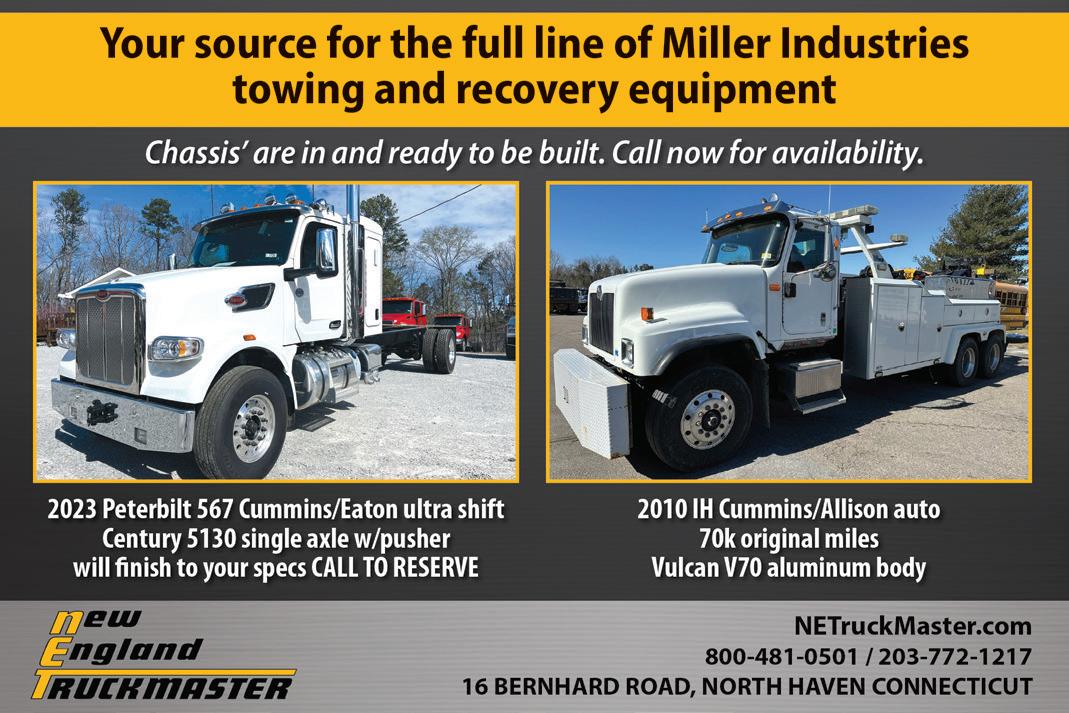
Susan Zinser, owner of D & S Tow in Sparks, said the bill removes accountability.
“If you can’t afford to register your car, that is a hardship,” she points out. “If you park on a fire hydrant or in a hospital loading zone, that’s not. Towing should be a deterrent to stop that behavior.” Zinser called towing
North 76 • May 2023 | Towman.com
News flash
A new Nevada bill would prevent towing unregistered cars from parking lots, and include a “hardship clause” for those who can’t pay storage fees.
“the teeth” of accountability.
Source: newsbreak.com
AAA Reports Rise in Women Hired in Automotive Roles
According to the AAA, more females are being hired as tow truck drivers and car-care techs than ever before, and women working in the automotive industry are encouraging other women to join them. The AAA of Oklahoma has seen an increase of more than 20 percent in the number of women hired for car care and automotive repair, and a jump of more than 35 percent in the number of women hired for fleet operations, including tow drivers.

Jessica Mckenzie, who manages AAA Car Care, has been working in the automotive industry for 13 years now, and says it is her passion.
“Right after high school, I went straight into Walmart and I became a manager over their automotive area because that’s where I wanted to be,” she

Work the non-traffic side - Stay Safe! AmericanTowman.com | May 2023 • North 77
related. “And ever since then…cars are my hobby. I like them.”
She adds that being a woman in a male-dominated industry gives her job more meaning,
“We are trying to actually get into more of a man side of things, so that way we can prove as women that we can do stuff just like a man could do,” Mckenzie noted. “I feel like there’s a lot more to go into our job than just being male or female. I feel like if you can do it, then go for it.”
Source: okcfox.com
New Jersey Towman Saves Motorist
Paul Carmeci, a towman at Nick’s Towing Service of Rutherford, New Jersey, pulled a motorist from an overturned vehicle that had careened about 60 feet away from an offramp at Rt. 17/ Rt. 3 highways.

On March 10, around 4:30 a.m., Carmeci was driving to work when the incident occurred. Sensing that something was wrong, Carmeci pulled to the
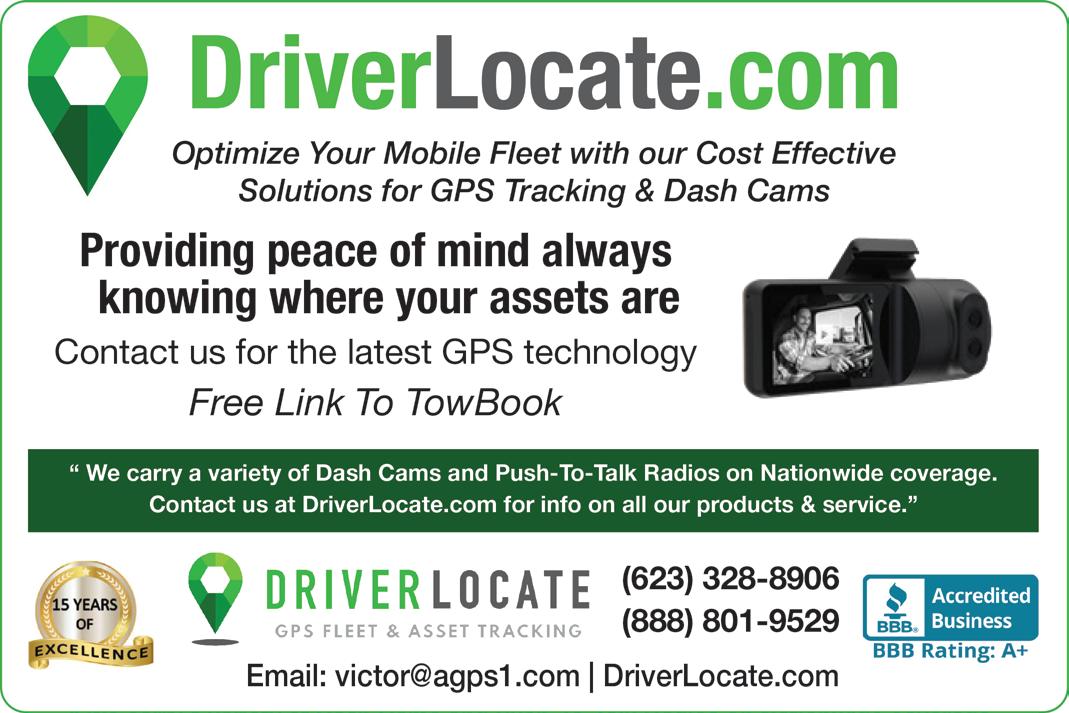
North 78 • May 2023 | Towman.com
side and donned his safety vest before evaluating the scene. There, he found a silver 2001 Mazda MX-5 rolled over onto its roof.
After assisting in a 911 call to provide the exact location, he proceeded to the car, where the driver had been thrown from the driver’s seat to the passenger side of the vehicle. The window was blown out, and he was cut and bleeding from his face and arms. Carmeci wrapped his arms around the man’s torso and pulled him out through the passenger window bringing him to safety just moments before the convertible roof collapsed. Carmeci did his best to stabilize the man’s neck while awaiting EMS arrival. A ten-year veteran at Nick’s, and a retired Marine who served in the Iraq War, Carmeci was modest about his rescue efforts.
“I’m not a hero,” he said. “I just did what anybody else would do, or should do.”
Sources: Nick’s Towing Service and dailyvoice.com


Work the non-traffic side - Stay Safe! AmericanTowman.com | May 2023 • North 79


North 80 • May 2023 | Towman.com

Copyright©2021 American Towman Magazine. Characters and stories are fictitious; no resemblance to real life characters is intended.
Episode 25

Send your thoughts/suggestions on the Adventures to scalitri@towman.com or American Towman, 2 Overlook Dr #5, Warwick NY 10990

Towing Companies Opposed to Nevada Bill
Tow companies are against Bill 303 proposed in Nevada, which is a refinement on an existing bill that restricts towing companies from taking non-registered cars from parking lots. The current law allows this practice, but towing companies must allow a 48-hour window before charging storage fees.
A lobbyist for the Nevada State Tow Association objects, stating that AB303 was far more than a refinement, and expands rules to all non-consent tows, not just apartment complexes.
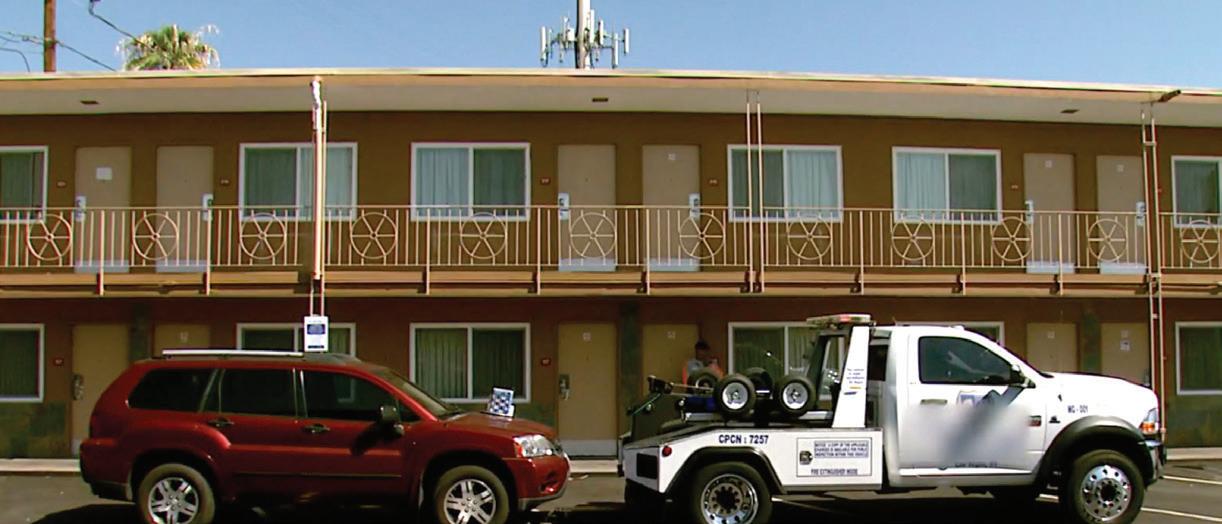
Tow companies are particularly opposed to AB303’s provisions to waive towing company fees when they would present a hardship. Those provisions would prevent fees from being assessed when the owner is unable to pay the normal rate charged, “for reasons outside of his or her control if the owner provides evidence.” These conditions, described by towing company representatives as the “hardship tariff discount,” take a significant chunk out of towing profits.
Susan Zinser, owner of D & S Tow
in Sparks, said the bill removes accountability.
“If you can’t afford to register your car, that is a hardship,” she points out. “If you park on a fire hydrant or in a hospital loading zone, that’s not. Towing should be a deterrent to stop that behavior.” Zinser called towing “the teeth” of accountability.
Source: newsbreak.com
AAA Reports Rise in Women Hired in Automotive Roles
According to the AAA, more females are being hired as tow truck drivers and car-care techs than ever before, and women working in the automotive industry are encouraging other women to join them. The AAA of Oklahoma has seen an increase of more than 20 percent in the number of women hired for car care and automotive repair, and a jump of more than 35 percent in the number of women hired for fleet operations, including tow drivers.
Jessica Mckenzie, who manages AAA Car Care, has been working in the automotive industry for 13 years now, and says it is her passion.
“Right after high school, I went
straight into Walmart and I became a manager over their automotive area because that’s where I wanted to be,” she related. “And ever since then…cars are my hobby. I like them.”
She adds that being a woman in a male-dominated industry gives her job more meaning,
“We are trying to actually get into more of a man side of things, so that way we can prove as women that we can do stuff just like a man could do,” Mckenzie noted. “I feel like there’s a lot more to go into our job than just being male or female. I feel like if you can do it, then go for it.”
Source: okcfox.com
New Jersey Towman Saves Motorist
Paul Carmeci, a towman at Nick’s Towing Service of Rutherford, New Jersey, pulled a motorist from an overturned vehicle that had careened about 60 feet away from an offramp at Rt. 17/Rt. 3 highways.
On March 10, around 4:30 a.m., Carmeci was driving to work when the incident occurred. Sensing that something was wrong, Carmeci pulled to the side and donned his
South 76 • May 2023 | Towman.com
News flash
A new Nevada bill would prevent towing unregistered cars from parking lots, and include a “hardship clause” for those who can’t pay storage fees.
safety vest before evaluating the scene. There, he found a silver 2001 Mazda MX-5 rolled over onto its roof.
After assisting in a 911 call to provide the exact location, he proceeded to the car, where the driver had been thrown from the driver’s seat to the passenger side of the vehicle. The window was blown out, and he was cut and bleeding from his face and arms. Carmeci wrapped his arms around the man’s torso and pulled him out through the passenger window bringing him to safety just moments before the convertible roof collapsed. Carmeci did his best to stabilize the man’s neck while awaiting EMS arrival. A ten-year veteran at Nick’s, and a retired Marine who served in the Iraq War, Carmeci was modest about his rescue efforts.
“I’m not a hero,” he said. “I just did what anybody else would do, or should do.”
Sources: Nick’s Towing Service and dailyvoice.com
Oklahoma Towman Dies from Collision
Kyle McCullough, a 27-year-old tow truck driver with Sooner Wrecker was struck on March 28 while assisting a motorist on I-40 just east of Shawnee, Oklahoma.
His girlfriend, Christina Skaggs, was in the wrecker and witnessed the event, saying that he had just strapped down a car when he was
hit by an oncoming semi-truck.
“I just felt we got hit,” she stated. “I looked up and I saw Kyle’s body flying and hit the ground.” McCullough is the father of two girls.
The semi that hit him left the scene, stopping four miles later. The driver, Shengjie Li, was arrested and taken to the County Jail on a $100,000 bond for leaving the scene of a fatal accident.
Source: kfor.com
Georgia Towman Killed by Drunk Driver
For the second time in less than a month, an Atlanta tow truck driver has died. Troy Simon, 41 years old, was in the process of loading
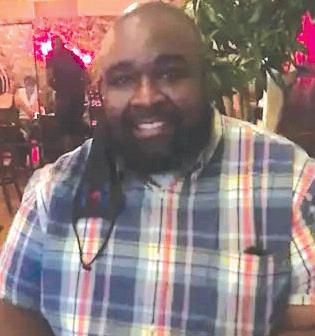
a vehicle just after midnight on March 26 when a driver under the influence hit a police car and then him.
“It is like a dream, a bad dream,” said Ashley Williams, Simon’s fiancé. “I just want to wake up from it.”
Medics rushed Simon from the collision scene near the Downtown Connector to Grady Memorial Hospital, where he died the next day.
“He had to go through three surgeries to stop the bleeding, but because he had lost oxygen for 20 minutes, he was basically like brain dead,” Williams said.
State Troopers arrested the driver who allegedly hit Simon and identified him as 22-year-old Troyvarius Crumedy. He faces several charges, including DUI.
“It is very frustrating, upsetting,” stated Angela Roper, Executive Vice President of the Towing and Recovery Association of Georgia. “It makes me very angry.”
Last month, Toby Bowden died on Interstate 85 in Coweta County. Both towers were engaged to be married.

If you want to help the family, they have created a GoFundMe.
Source: fox5atlanta.com
First Responders Honor Fallen Georgia Towman
Hundreds turned out, many driving in procession, to honor fallen Georgia towman Toby Bowden, on March 22. Bowden lost his life working on Interstate 85 in Coweta County, Georgia. He was cleaning up a crash with emergency
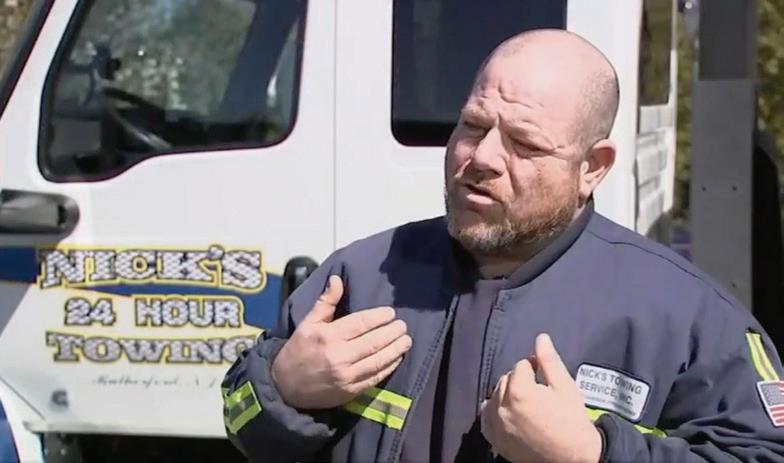
Work the non-traffic side - Stay Safe! AmericanTowman.com | May 2023 • South 77
Paul Carmeci came to the rescue of a motorist in an overturned car.
Kyle McCullough (right) was killed while handling a roadside recovery.
◀
Troy Simon is the second Georgia towman to die recently.
crews when investigators say a driver going too fast for conditions swerved to avoid fire trucks and rolled over hitting Bowden.
According to Donna Robards, owner of Twisted Hook LLC, Toby was scheduled to be married in September. “He was a veteran,
serving four years in the marines and came out and went to work as a tow operator,” she said. “It’s heartbreaking to realize how many tow ops and first responders we lose every year.”

Source: times-herald.com
Tow Company Takes City to Court

State Towing Service, Inc., of Providence, Rhode Island, has filed a lawsuit against the city for not paying invoices and assigning a lucrative towing contract to another company.
To complicate matters, the tow company’s lawyer alleged that Councilman James Taylor sought a donation from State Towing to his campaign, and when he didn’t receive it, went after the company with an internal audit. The councilman denies the charges, maintaining that his actions were precipitated by red flags in State Towing’s billing.
State Towing has been doing various towing work for the city for about 18 years. It has faced increased costs, though, for removing things like campers, ATVs, boats, and trailers, because those vehicles were often filled with debris. Then-Public Safety Commissioner, Steven Paré, assured the company that it would be reimbursed for these additional costs, the lawsuit said. But instead, unpaid invoices for towing work piled up.
“State Towing has been providing services to the city of Providence for decades,” Paré said in an interview. “And the invoices submitted in the last two years are reflective of the work that they’ve provided to the city. And State Towing should be made whole for those services.”
In October, after State Towing’s demands, the city paid about $309,000 of $415,000 in outstanding invoices, the suit says. The company says it’s still owed about $106,000.
South 78 • May 2023
| Towman.com
A procession of tow trucks honored Georgia towman Toby Bowden. Photo credit: Clay Neely / The Newnan Times-Herald
State Towing Service of Rhode Island is fighting Providence over unpaid invoices and a tow contract.
In the meantime, the city put out a new request for proposals for towing city-owned and abandoned vehicles after an audit by a city inspector. State Towing claims they were the lowest bidder, but a competing tow company was given the better part of the contract involving the higher priced tows for campers, ATV’s, boats and trailers.

Source: bostonglobe.com
Man Arrested in Connecticut Towman’s Death
A man who struck and killed a tow truck driver in Connecticut was charged for his actions. After an arrest warrant was issued for Luis Resto on March 30, he turned himself in.
The tow truck driver, Christopher Russell, was off-duty on his way home when he stopped to help a woman with a flat tire on I-91 in New Haven, Connecticut. As he was walking back to his truck, he was hit by Resto.

“He loved helping people,” said L.J. Miller, Russell’s friend and former coworker. “He was caring. Had a great heart. Loved animals. Just a good soul.”
After leaving the scene, court documents said Resto kept driving. A witness gave police dashcam video showing Resto’s Nissan Rogue traveling across all three Interstate 91 northbound lanes, until Resto
crashed into a guardrail.
Court documents indicate that Resto told police that he, “snorted a whole bag of heroin and subsequently ‘blacked out’ while operating the Nissan Rogue on Interstate 91 North.” He told them he did not remember hitting Russell.
After an 11-month investigation, police charged Resto with the following violations: Manslaughter in the 2nd Degree with a Motor Vehicle, Reckless Endangerment 1st Degree, Misconduct with a Motor Vehicle, Possession of a Controlled Substance 2nd Offense, Operating a Motor Vehicle Under the Influence of Drugs/Alcohol, Evading Responsibility Resulting in Death, Failure to Maintain Proper Lane, and Illegal Operation Failing to Move Over for an Emergency Vehicle.
A fundraiser will be held for Russell on May 21 to raise funds for a headstone and help Russell’s mother with funeral expenses.
Source: fox61.com
Work the non-traffic side - Stay Safe! AmericanTowman.com | May 2023 • South 79
Christopher Russell was killed after a man, high on heroin, struck him.


South 80 • May 2023 | Towman.com

Copyright©2021 American Towman Magazine. Characters and stories are fictitious; no resemblance to real life characters is intended.
Episode 25

Send your thoughts/suggestions on the Adventures to scalitri@towman.com or American Towman, 2 Overlook Dr #5, Warwick NY 10990

Towing Companies Opposed to Nevada Bill
Tow companies are against Bill 303 proposed in Nevada, which is a refinement on an existing bill that restricts towing companies from taking non-registered cars from parking lots. The current law allows this practice, but towing companies must allow a 48-hour window before charging storage fees.
A lobbyist for the Nevada State Tow Association objects, stating that AB303 was far more than a refinement, and expands rules to all non-consent tows, not just apartment complexes.

Tow companies are particularly opposed to AB303’s provisions to waive towing company fees when they would present a hardship. Those provisions would prevent fees from being assessed when the owner is unable to pay the normal rate charged, “for reasons outside of his or her control if the owner provides evidence.” These conditions, described by towing company representatives as the “hardship tariff discount,” take a significant chunk out of towing profits.
Susan Zinser, owner of D & S Tow
in Sparks, said the bill removes accountability.
“If you can’t afford to register your car, that is a hardship,” she points out. “If you park on a fire hydrant or in a hospital loading zone, that’s not. Towing should be a deterrent to stop that behavior.” Zinser called towing “the teeth” of accountability.
Source: newsbreak.com
AAA Reports Rise in Women Hired in Automotive Roles
According to the AAA, more females are being hired as tow truck drivers and car-care techs than ever before, and women working in the automotive industry are encouraging other women to join them. The AAA of Oklahoma has seen an increase of more than 20 percent in the number of women hired for car care and automotive repair, and a jump of more than 35 percent in the number of women hired for fleet operations, including tow drivers.
Jessica Mckenzie, who manages AAA Car Care, has been working in the automotive industry for 13 years now, and says it is her passion.
“Right after high school, I went
straight into Walmart and I became a manager over their automotive area because that’s where I wanted to be,” she related. “And ever since then…cars are my hobby. I like them.”
She adds that being a woman in a male-dominated industry gives her job more meaning,
“We are trying to actually get into more of a man side of things, so that way we can prove as women that we can do stuff just like a man could do,” Mckenzie noted. “I feel like there’s a lot more to go into our job than just being male or female. I feel like if you can do it, then go for it.”
Source: okcfox.com
New Jersey Towman Saves Motorist
Paul Carmeci, a towman at Nick’s Towing Service of Rutherford, New Jersey, pulled a motorist from an overturned vehicle that had careened about 60 feet away from an offramp at Rt. 17/Rt. 3 highways.
On March 10, around 4:30 a.m., Carmeci was driving to work when the incident occurred. Sensing that something was wrong, Carmeci pulled to the side and donned
Midwest 76 • May 2023 | Towman.com
News flash
◀
A new Nevada bill would prevent towing unregistered cars from parking lots, and include a “hardship clause” for those who can’t pay storage fees.

his safety vest before evaluating the scene. There, he found a silver 2001 Mazda MX-5 rolled over onto its roof.
After assisting in a 911 call to provide the exact location, he proceeded to the car, where the driver had been thrown from the driver’s seat to the passenger side of the vehicle. The window was blown out, and he was cut and bleeding from his face and arms. Carmeci wrapped his arms around the man’s torso and pulled him out through
the passenger window bringing him to safety just moments before the convertible roof collapsed.
Carmeci did his best to stabilize the man’s neck while awaiting EMS arrival. A ten-year veteran at Nick’s, and a retired Marine who served in the Iraq War, Carmeci was modest about his rescue efforts.
“I’m not a hero,” he said. “I just did what anybody else would do, or should do.”
Sources: Nick’s Towing Service and dailyvoice.com
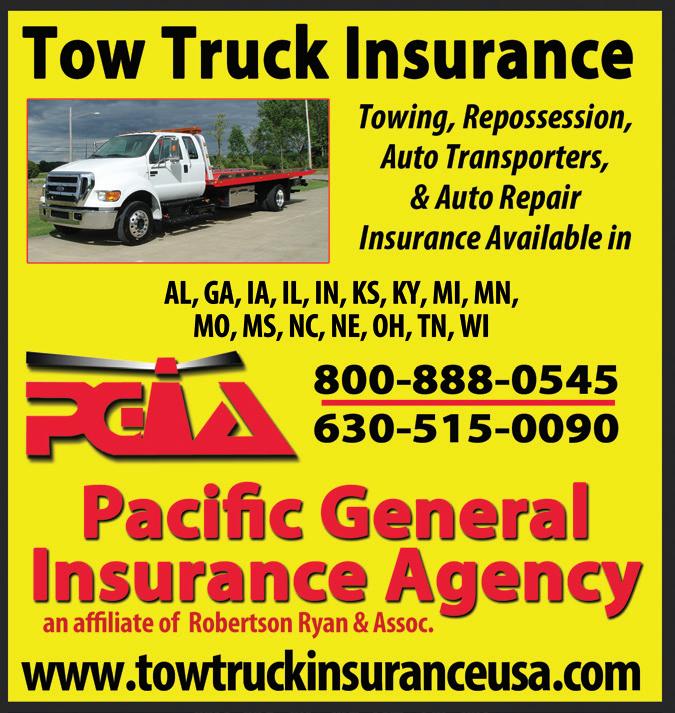
Oklahoma Towman Dies from Collision
Kyle McCullough, a 27-year-old tow truck driver with Sooner Wreck-
er was struck on March 28 while assisting a motorist on I-40 just east of Shawnee, Oklahoma.
His girlfriend, Christina Skaggs, was in the wrecker and witnessed the event, saying that he had just strapped down a car when he was hit by an oncoming semi-truck.
“I just felt we got hit,” she stated. “I looked up and I saw Kyle’s body flying and hit the ground.” McCullough is the father of two girls.
The semi that hit him left the scene, stopping four miles later. The driver, Shengjie Li, was arrested and taken to the County Jail on a $100,000 bond for leaving the scene of a fatal accident.
Source: kfor.com
Georgia Towman Killed by Drunk Driver
For the second time in less than a month, an Atlanta tow truck driver has died. Troy Simon, 41 years old, was in the process of loading a vehicle just after midnight on March 26 when a driver under the influence hit a police car and then him.


“It is like a dream, a bad dream,” said Ashley Williams, Simon’s fiancé. “I just want to wake up from it.”
Medics rushed Simon from the collision scene near the Downtown
Midwest 78 • May 2023 | Towman.com
Paul Carmeci came to the rescue of a motorist in an overturned car.
Kyle McCullough (right) was killed while handling a roadside recovery.
Connector to Grady Memorial Hospital, where he died the next day.
“He had to go through three surgeries to stop the bleeding, but because he had lost oxygen for 20 minutes, he was basically like brain dead,” Williams said.
State Troopers arrested the driver who allegedly hit Simon and identified him as 22-yearold Troyvarius Crumedy. He faces several charges, including DUI.
“It is very frustrating, upsetting,” stated Angela Roper, Executive Vice President of the Towing and Recovery Association of Georgia. “It makes me very angry.”
Last month, Toby Bowden died on Interstate 85 in Coweta County. Both towers were engaged to be married.
If you want to help the family, they have created a GoFundMe.

Source: fox5atlanta.com
First Responders Honor Fallen Georgia Towman
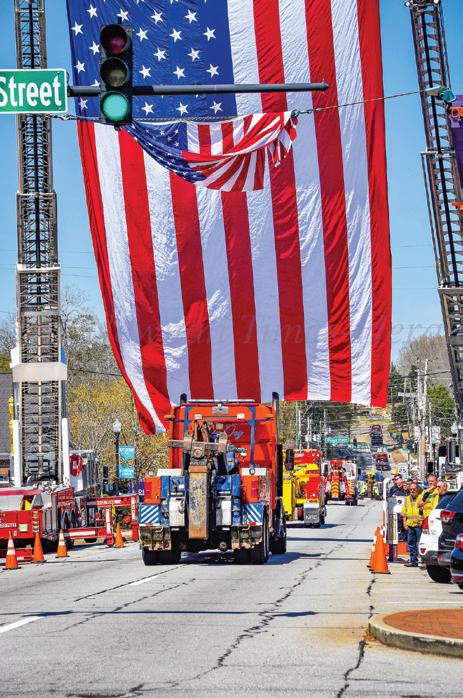
Hundreds turned out, many driving in procession, to honor fallen Georgia towman Toby Bowden, on March 22. Bowden lost his life working on Interstate 85 in Coweta County, Georgia. He was cleaning up a crash with emergency crews when investigators say a driver going too fast for conditions swerved to avoid fire trucks and rolled over hitting Bowden.
According to Donna Robards, owner of Twisted Hook LLC, Toby was scheduled to be married in September. “He was a veteran, serving four years in the marines and came out and went to work as a tow operator,” she said. “It’s heartbreaking to realize how many tow ops and first responders we lose every year.”
Source: times-herald.com
Work the non-traffic side - Stay Safe! AmericanTowman.com | May 2023 • Midwest 79
A procession of tow trucks honored Georgia towman Toby Bowden. Photo credit: Clay Neely / The Newnan Times-Herald


Midwest 80 • May 2023 | Towman.com

Copyright©2021 American Towman Magazine. Characters and stories are fictitious; no resemblance to real life characters is intended.
Episode 25

Send your thoughts/suggestions on the Adventures to scalitri@towman.com or American Towman, 2 Overlook Dr #5, Warwick NY 10990

Towing Companies Opposed to Nevada Bill
Tow companies are against Bill 303 proposed in Nevada, which is a refinement on an existing bill that restricts towing companies from taking non-registered cars from parking lots. The current law allows this practice, but towing companies must allow a 48-hour window before charging storage fees.
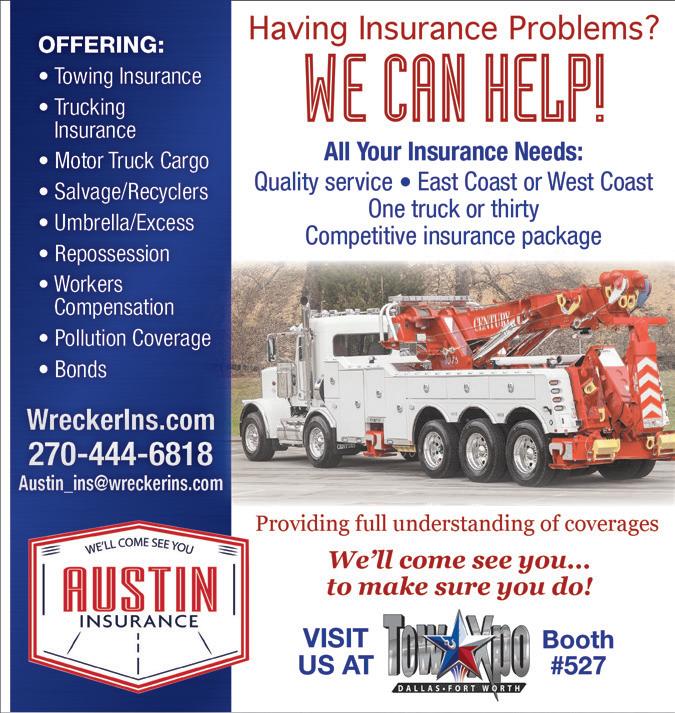
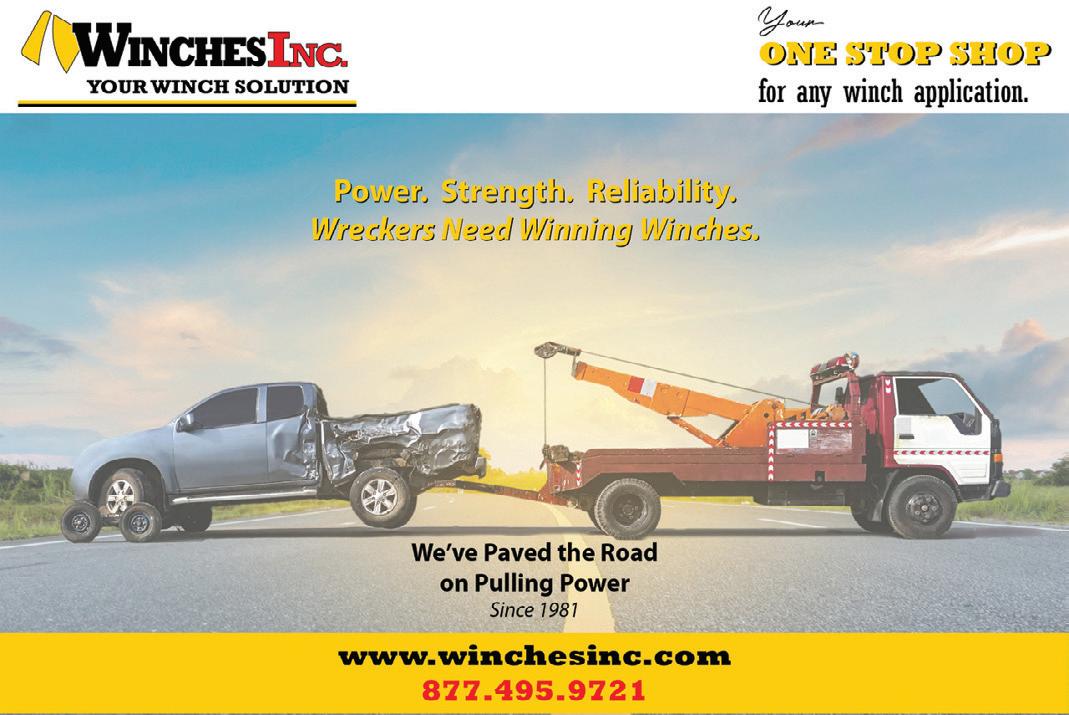
A lobbyist for the Nevada State Tow Association objects, stating that AB303 was far more than a refinement, and expands rules to all non-consent tows,

West 76 • May 2023 | Towman.com
News flash ◀
A new Nevada bill would prevent towing unregistered cars from parking lots, and include a “hardship clause” for those who can’t pay storage fees.
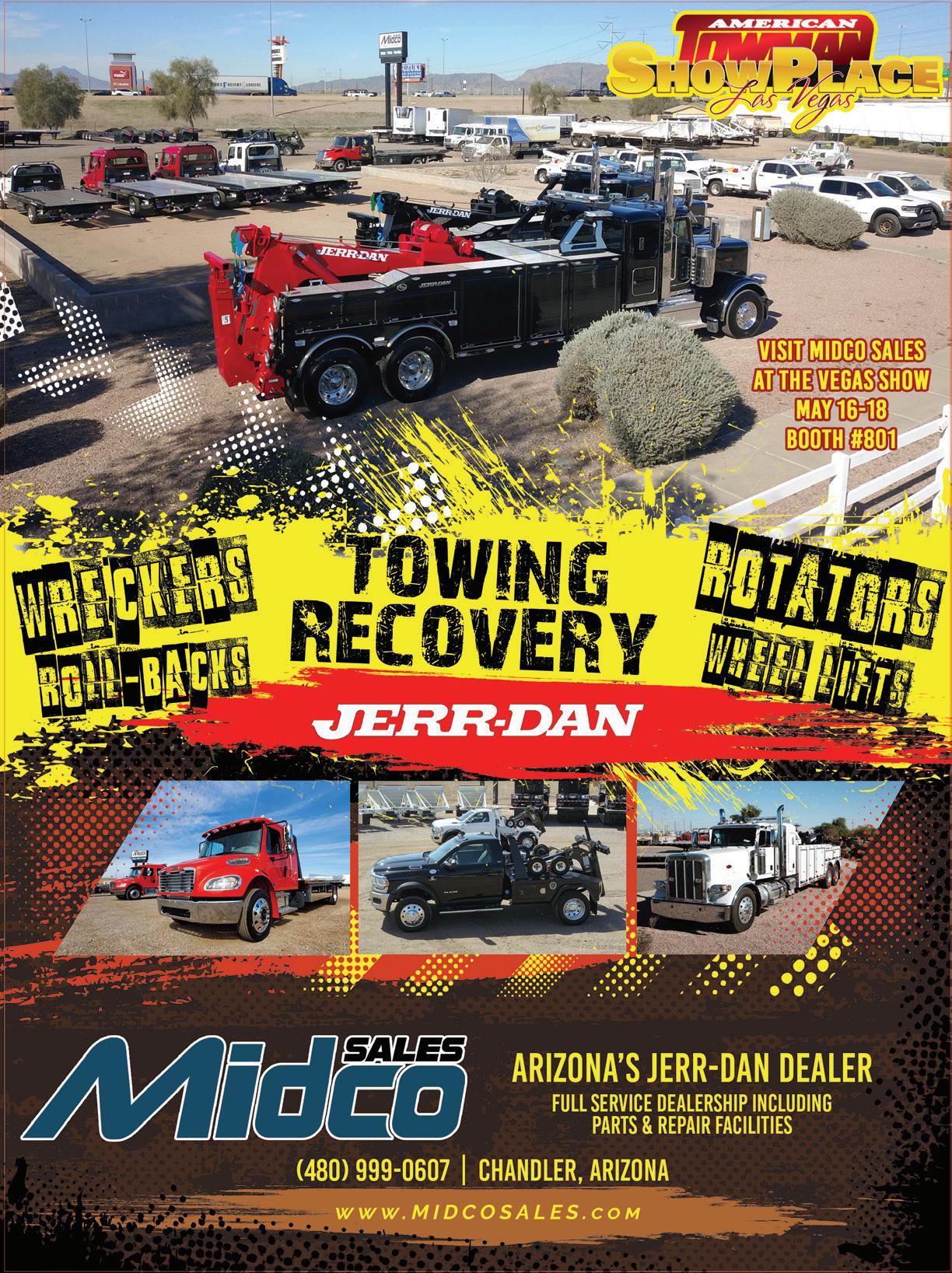
not just apartment complexes.
Tow companies are particularly opposed to AB303’s provisions to waive towing company fees when they would present a hardship. Those provisions would prevent fees from being assessed when the owner is unable to pay the normal rate charged, “for reasons outside of his or her control if the owner provides evidence.” These conditions, described by towing company representatives as the “hardship tariff discount,” take a significant chunk out of towing profits.

Susan Zinser, owner of D & S Tow in Sparks, said the bill removes accountability.

“If you can’t afford to register your car, that is a hardship,” she points out. “If you park on a fire hydrant or in a hospital loading zone, that’s not. Towing should be a deterrent to stop that behavior.” Zinser called towing “the teeth” of accountability.
Source: newsbreak.com
West 78 • May 2023 | Towman.com


Work the non-traffic side - Stay Safe! AmericanTowman.com | May 2023 • West 79


West 80 • May 2023 | Towman.com

Copyright©2021 American Towman Magazine. Characters and stories are fictitious; no resemblance to real life characters is intended.
Episode 25

Send your thoughts/suggestions on the Adventures to scalitri@towman.com or American Towman, 2 Overlook Dr #5, Warwick NY 10990
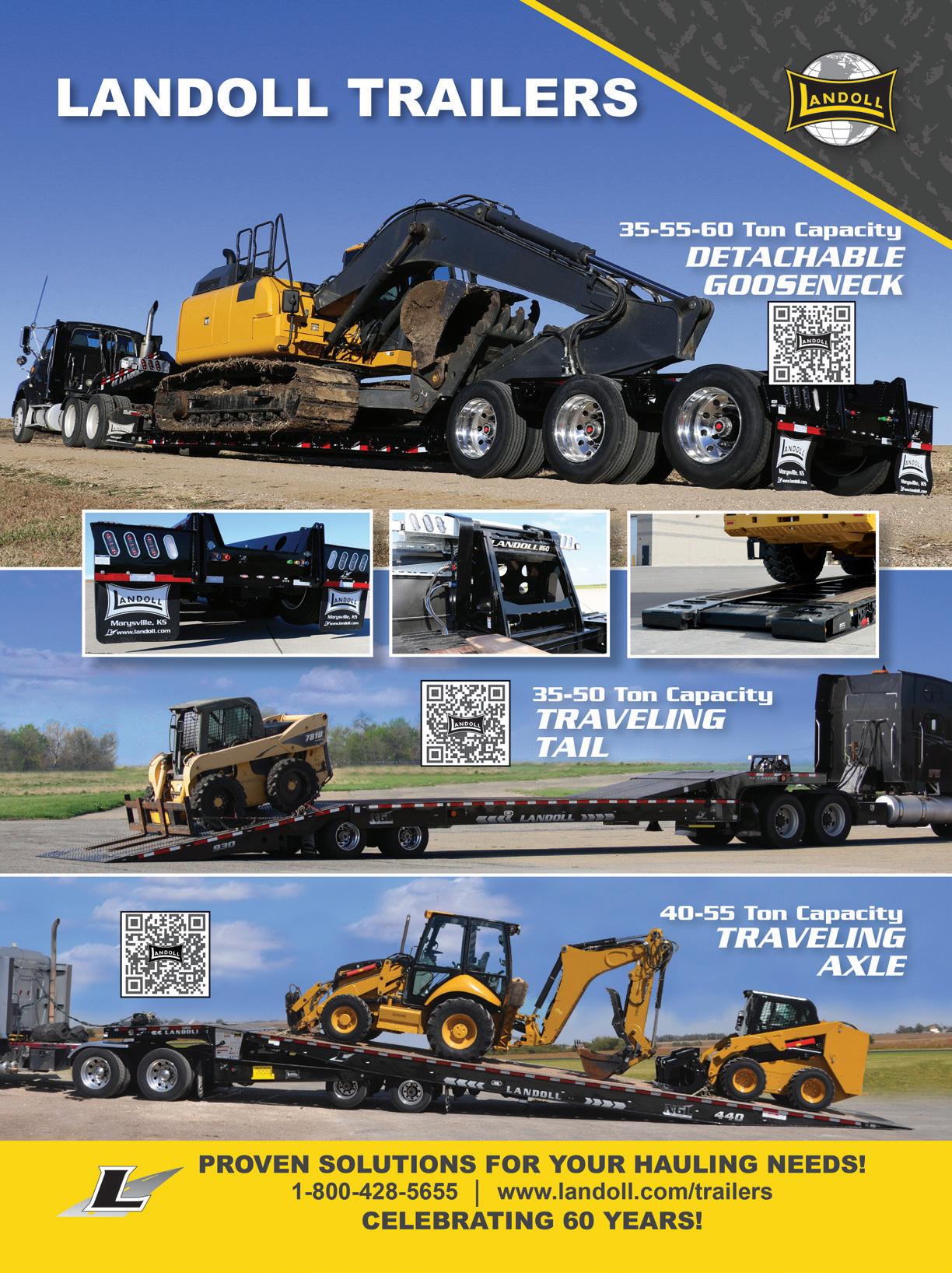
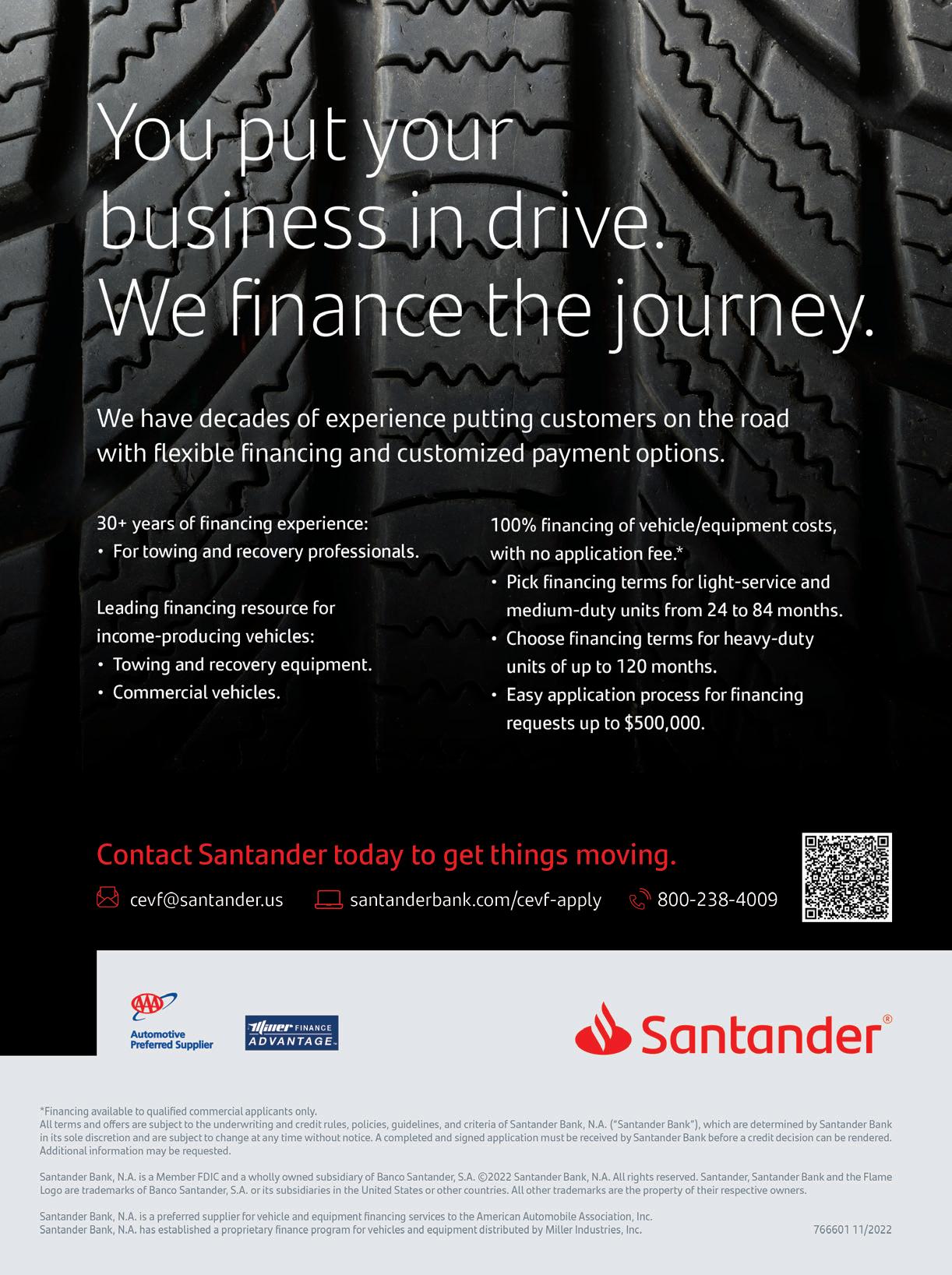




 by John Borowski
by John Borowski
 by George Nitti
by George Nitti

 by Brian J. Riker
by Brian J. Riker






































































































 By Terry Abejuela
By Terry Abejuela


















































































